"Last Ride of the Valkyries" A German '44 Gotterdammerung Revised AAR
- Thread starter LimaTango
- Start date
-
We have updated our Community Code of Conduct. Please read through the new rules for the forum that are an integral part of Paradox Interactive’s User Agreement.
You are using an out of date browser. It may not display this or other websites correctly.
You should upgrade or use an alternative browser.
You should upgrade or use an alternative browser.
August 13, 1944
With Operation Luttich complete, the focus shifts to the continuous fighting on the Ostfront. The Red Army never rests, attacking each territory in turn. The next ones are Iasi and Jekapils.
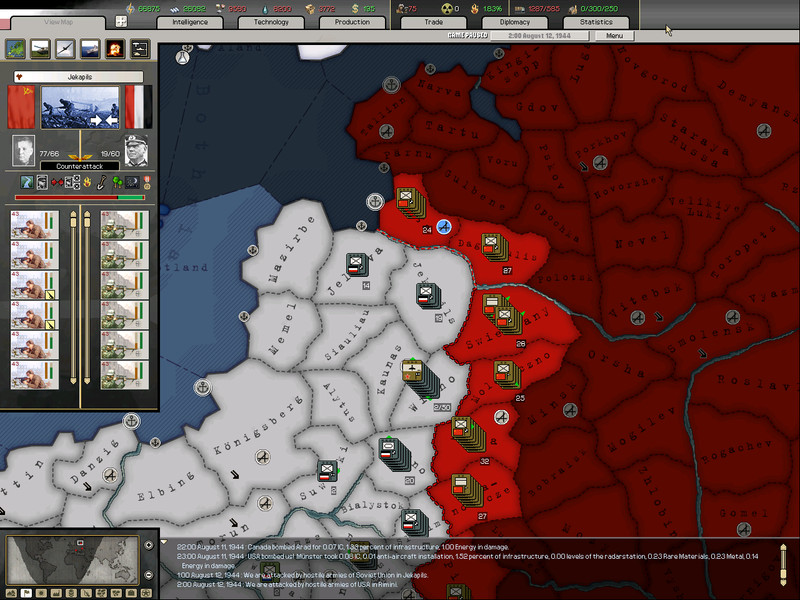
In both cases the nearest mobile forces are rushed to the front, seeking to blunt the Red Army spearheads.
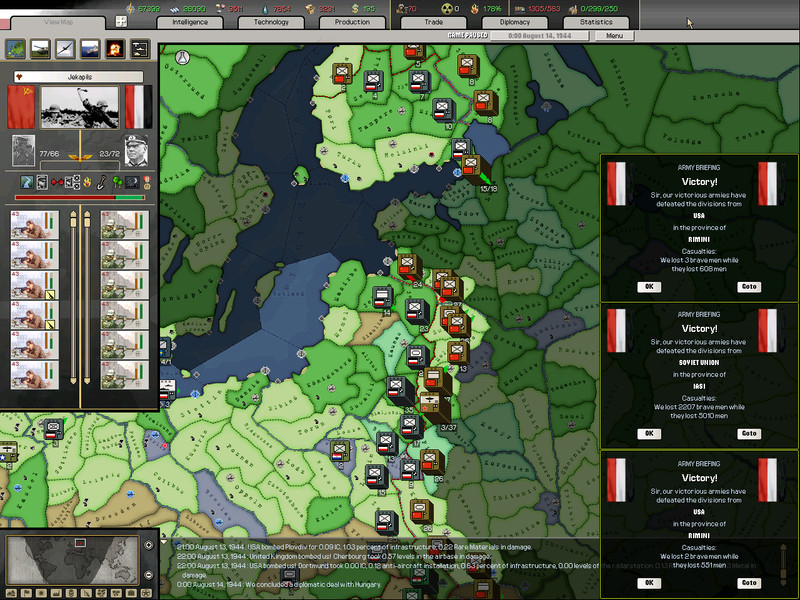
The Luftwaffe continues to scrape together a semblance of an air defense network. The very heart of Germany is defended, but the rest of the Reich is being flattened.
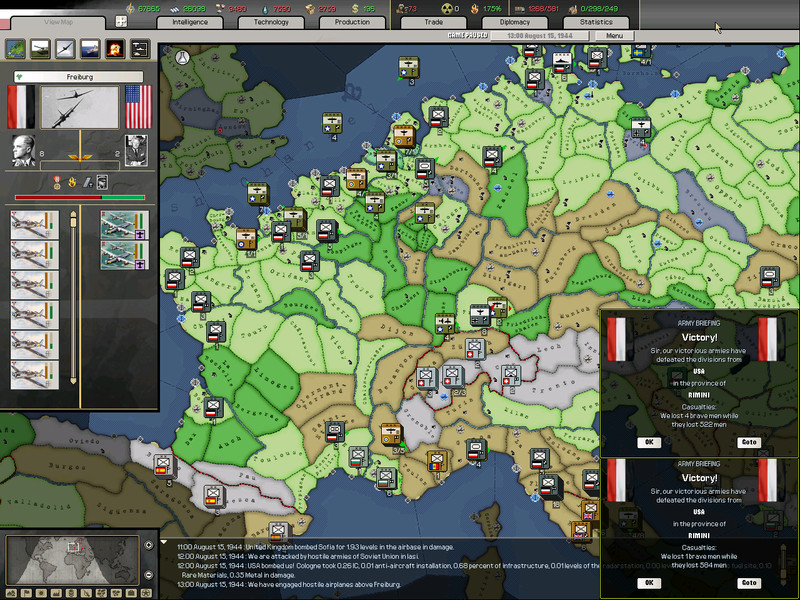
FM Model continues to hold Iasi against the Red tide. His men are tiring, but they continue to lay down a withering fire over the river.
The defenders in Jekapils have a river as well, but only on one side. They struggle to hold the Soviets at bay.
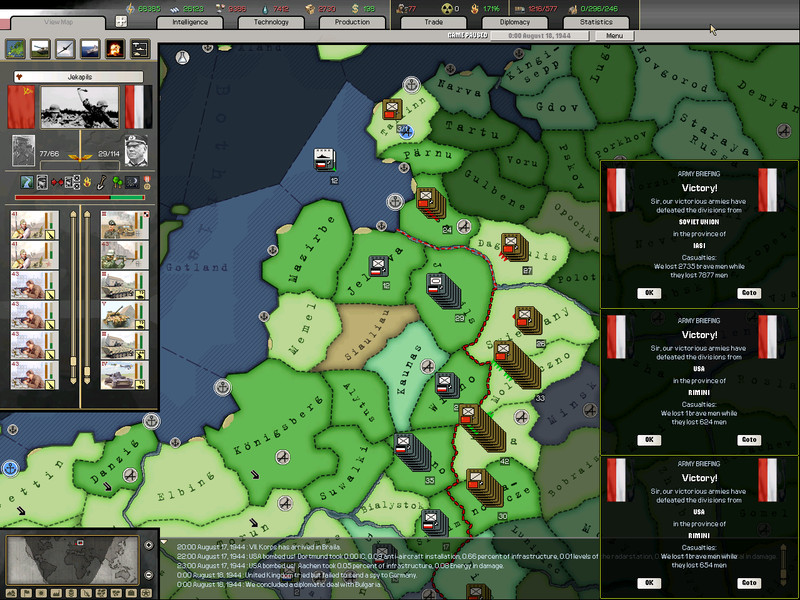
Jekapils holds, but STAVKA orders an immediate attack on Wilno to the south. The few Wehrmacht reserves cannot keep up this pace.
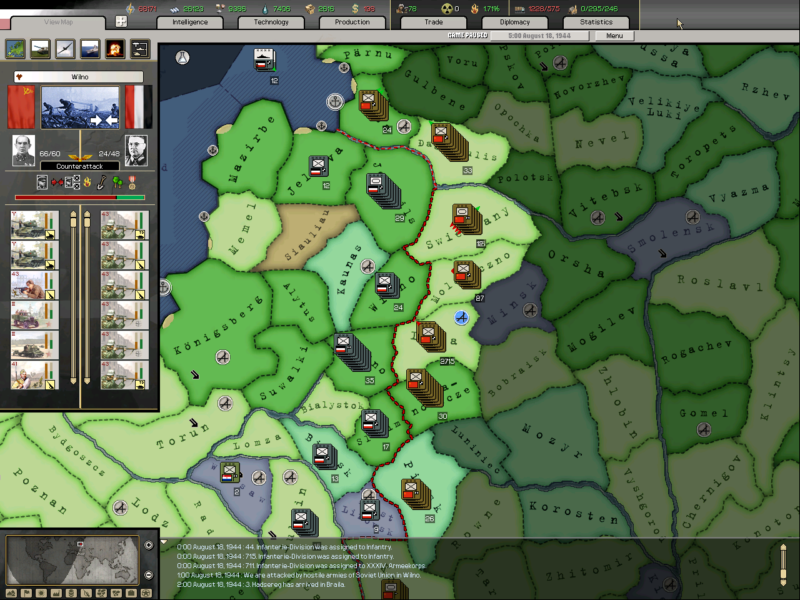
Reinforcements from France arrive via sea in Jelgava. The railroad deployments are some days away, in September. The dozen divisions from France seem a thin reed to hold back the bear.
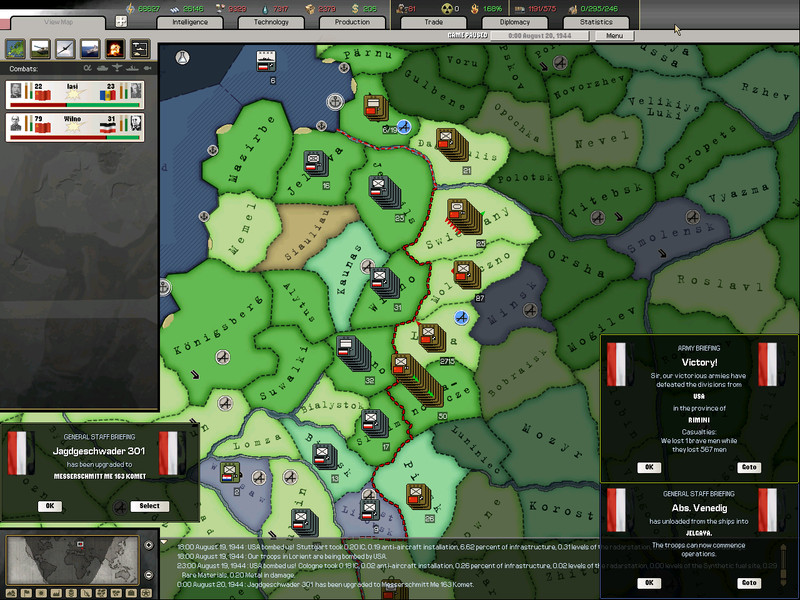
Model holds in Iasi again, but STAVKA immediately counters at Slonim.
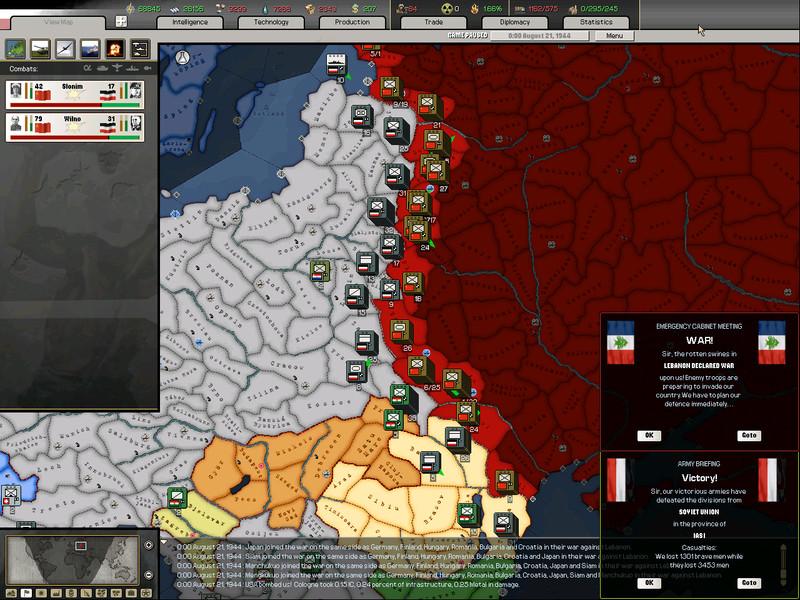
Field Marshal Busse skillfully counterattacks but the attackers have over twice his divisions, and each Soviet division is almost twice the strength of each of his.
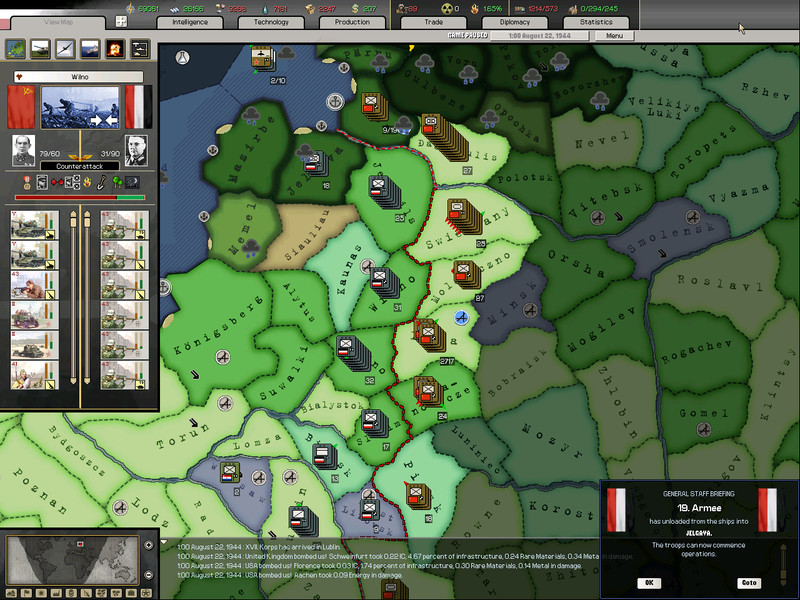
It happens on August 23. The Godan line cracks at Wilno. Heersgruppe Nord commander FM von Rundstedt orders withdrawals from Wilno and advises von Manstein of his opening flank in HG Mitte.
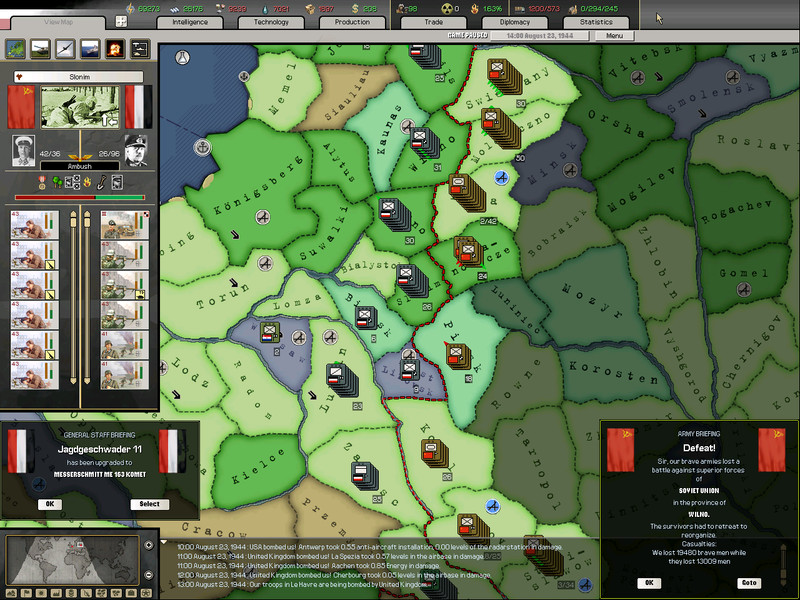
The Heer in Slonim begins to break down. They have been called on to do too much, with low supplies and no reinforcements. When they hear of Red Army troops in Wilno they request a move west to the next line of defenses.
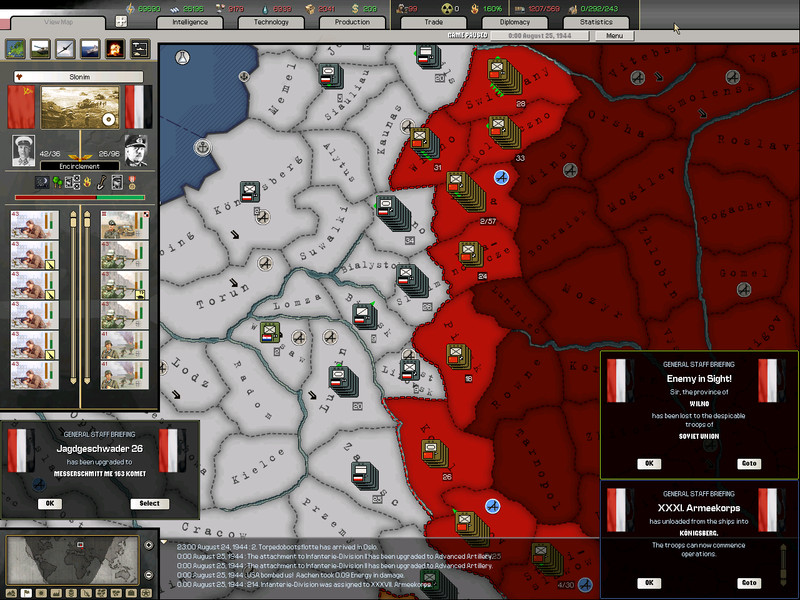
The Godan line is abandoned across HG Nord’s area of responsibility. The only bright spot for the High Command is that the Heer is inflicting more losses than they are taking now.
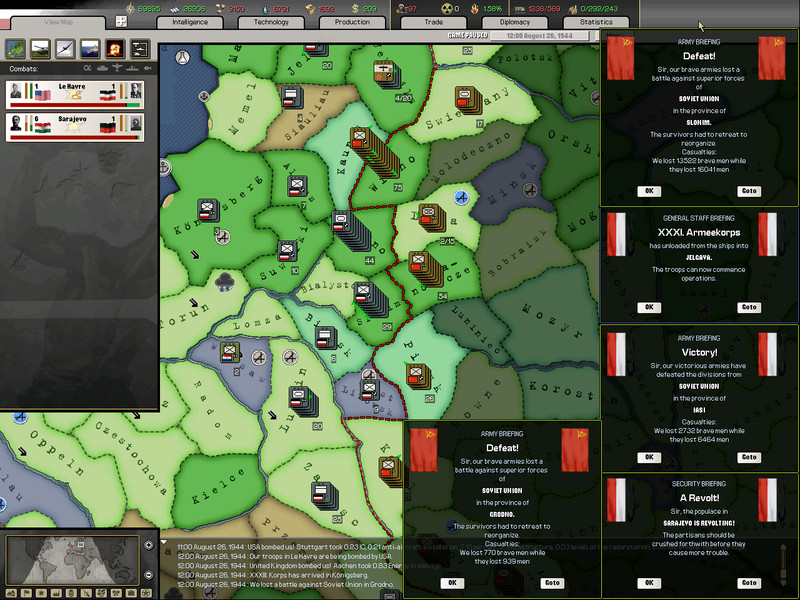
Rommel arrives in Konigsberg, grimacing at the ranks of retreating Wehrmacht formations. The sky is devoid of friendly aircraft, but mercifully the Red Air Force is also seemingly grounded for repairs.
The partisans in Sarajevo fight like cornered rats, to the last man.
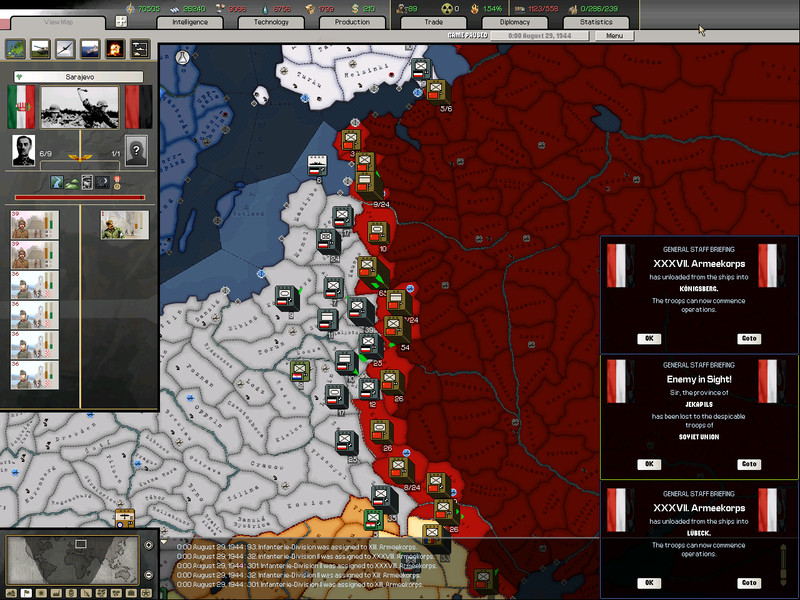
August ends with a resounding “thud” as HG Nord digs in frantically at their last line before Konigsberg. General Jodl asks von Rundstedt if he can hold in place. The staff cannot hear the response on the field phone, but Jodl’s face is a mask of anguish.
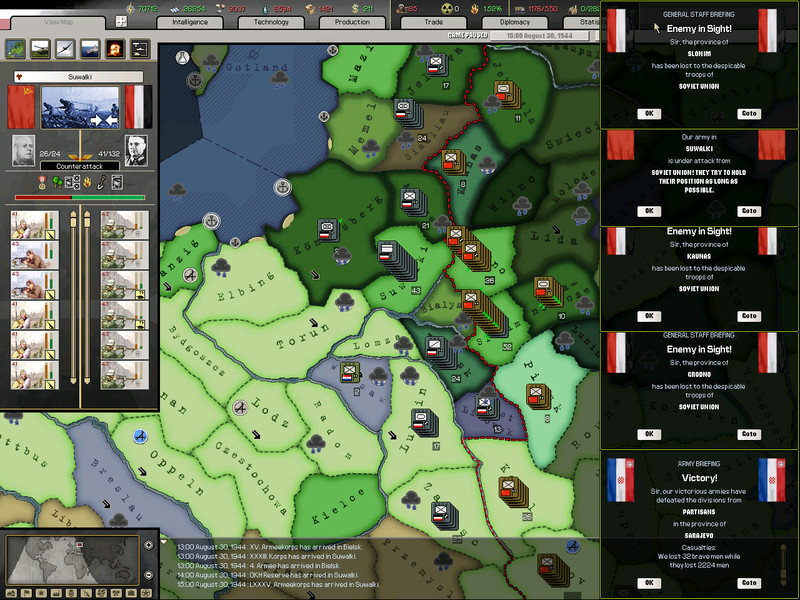
With Operation Luttich complete, the focus shifts to the continuous fighting on the Ostfront. The Red Army never rests, attacking each territory in turn. The next ones are Iasi and Jekapils.

In both cases the nearest mobile forces are rushed to the front, seeking to blunt the Red Army spearheads.

The Luftwaffe continues to scrape together a semblance of an air defense network. The very heart of Germany is defended, but the rest of the Reich is being flattened.

FM Model continues to hold Iasi against the Red tide. His men are tiring, but they continue to lay down a withering fire over the river.
The defenders in Jekapils have a river as well, but only on one side. They struggle to hold the Soviets at bay.

Jekapils holds, but STAVKA orders an immediate attack on Wilno to the south. The few Wehrmacht reserves cannot keep up this pace.

Reinforcements from France arrive via sea in Jelgava. The railroad deployments are some days away, in September. The dozen divisions from France seem a thin reed to hold back the bear.

Model holds in Iasi again, but STAVKA immediately counters at Slonim.

Field Marshal Busse skillfully counterattacks but the attackers have over twice his divisions, and each Soviet division is almost twice the strength of each of his.

It happens on August 23. The Godan line cracks at Wilno. Heersgruppe Nord commander FM von Rundstedt orders withdrawals from Wilno and advises von Manstein of his opening flank in HG Mitte.

The Heer in Slonim begins to break down. They have been called on to do too much, with low supplies and no reinforcements. When they hear of Red Army troops in Wilno they request a move west to the next line of defenses.

The Godan line is abandoned across HG Nord’s area of responsibility. The only bright spot for the High Command is that the Heer is inflicting more losses than they are taking now.

Rommel arrives in Konigsberg, grimacing at the ranks of retreating Wehrmacht formations. The sky is devoid of friendly aircraft, but mercifully the Red Air Force is also seemingly grounded for repairs.
The partisans in Sarajevo fight like cornered rats, to the last man.

August ends with a resounding “thud” as HG Nord digs in frantically at their last line before Konigsberg. General Jodl asks von Rundstedt if he can hold in place. The staff cannot hear the response on the field phone, but Jodl’s face is a mask of anguish.

@Sandetje Forces are on the move to Italy, but the TC is so high that no attack can be supported at the moment. September will be the time for the boot.
******************************
Chancellery
September 1, 1944
There are a few small smiles around the conference table as the attendees greet one another and settle into their seats. After all, one very immediate threat to the Fatherland had been removed, at least for the moment. Still, as Chancellor Speer moved to the head of the table, the room grew somber again. The situation was still very grim.
“We are all aware of the magnificent performance of the Wehrmacht in the West. The Volk have rejoiced at this reprieve from the Allied menace. This was work well done.”
“And to you as well, Albert,” pipes up Guderian, “you got enough men and material together to allow the Heer to make that stand.”
“Thank you, Heinz. It was indeed a case of everyone pulling their weight. Now, we have some time to wait, as the re-deployment of troops from the West to other theaters has completely overwhelmed our diminished transportation grid. Martin?”
“Yes, Albert, we will not achieve even the level of “seriously overburdened” transportation network until September 20th or so. As regards other resources, we can support the limited production we have remaining (at this Air Marshal Milch tightens his lips). Our manpower is only available by disbanding divisions that are no longer battle worthy. This will be the case for months to come.”
Seeing his cue, General Jodl rises. “The Heer is giving ground in the East. We have raised a new line just east for Konigsberg. It is even money whether it can be held there. The divisions from the West cannot arrive too soon.
The forces for Operation Stiefelschlacht in Italy are in place, regaining organization and replacing their losses. They will be fully ready in one week but we must wait a bit until we have some hope of resupplying them. We suspect that Allied stockpiles will be out of reach in Sicily, so we have little expectation of succor in that regard. I do have one gambit that Rommel has whispered to me, but that can be discussed at a later date.”
The Air Marshal is looking haggard as he begins. “All bombers remain grounded, without repairs or upgrading. All dogfighters are being reinforced and a few have been upgraded to the Komet aircraft. We are now having some success in the skies over central Germany, but we cannot expand operations outward at this point. I am hopeful that the Allied airbases in Italy can be overrun, just to back them off of the relentless strikes on southern Germany. That’s all”
Admiral Doenitz rises briefly. “We are shelling Riga in support of HG Nord, and we are moving troops from west to east. All surface craft are 100% repaired and all U-boats are repairing in port at this time. We have two U-boat flotillas in the Med, which will follow any orders in support of Heersgruppe Mittelmeer.”
Kaltenbrunner takes the stage. “Here are the reports that the Abwehr has prepared. The enemy INTSUM or intelligence summary are liable to be wildly inaccurate with the limited resources we have in place at this time. We will improve this performance if and when we can fund new recruitment.
First up is the Soviet Union. Their army is massive and their navy is miniscule. The figures for their air force seem exaggerated, though they are plentiful enough. Few of their divisions are at full strength.
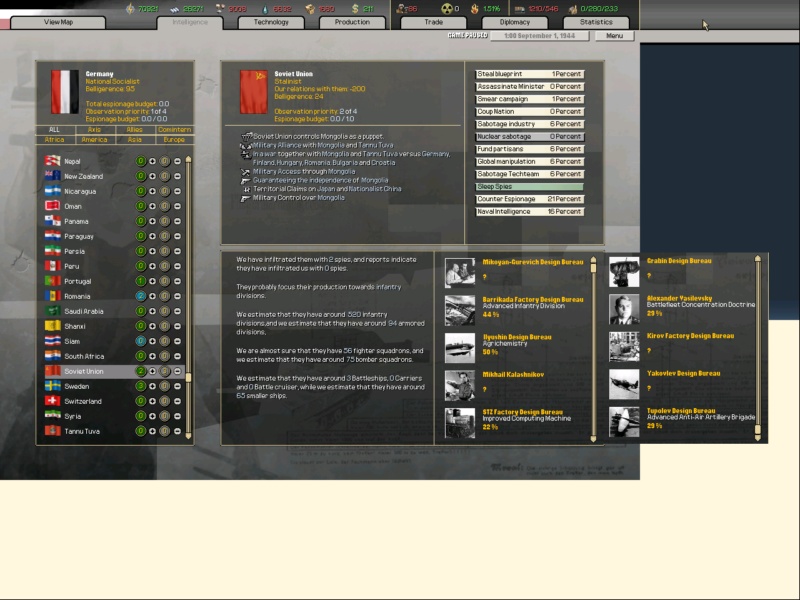
The next foe is the United Kingdom. We once had them on their knees but they retain an impressive fleet.
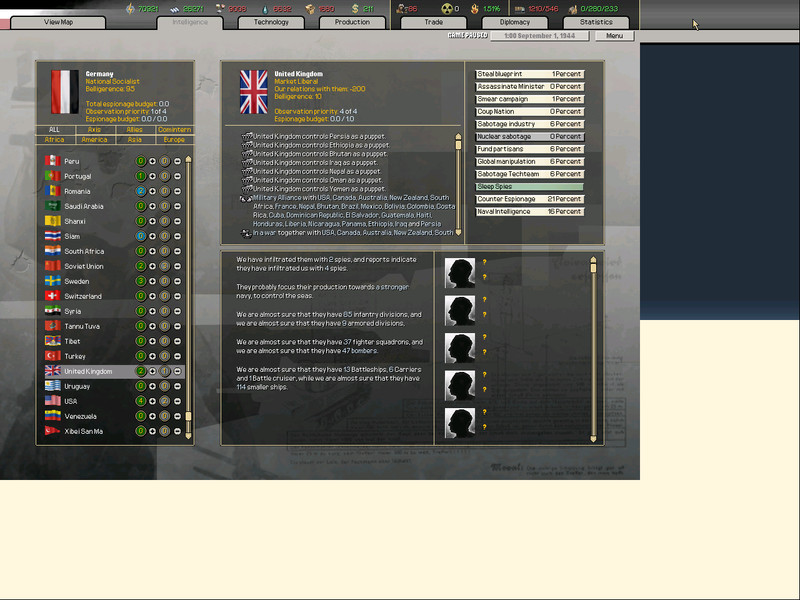
And there is the United States. They are now unrivalled at sea and in the air, but their ground forces are not as numerous. They can replace losses faster than we have been able to inflict them though.
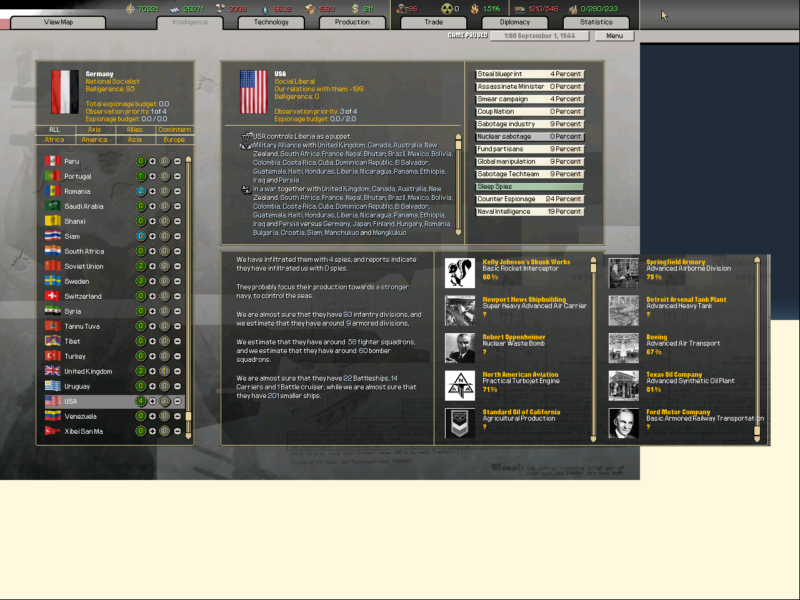
Our ally Japan is struggling. They are advancing in China and falling back in Burma. If you will note their fleet size, it is clear that they have been mauled at sea.
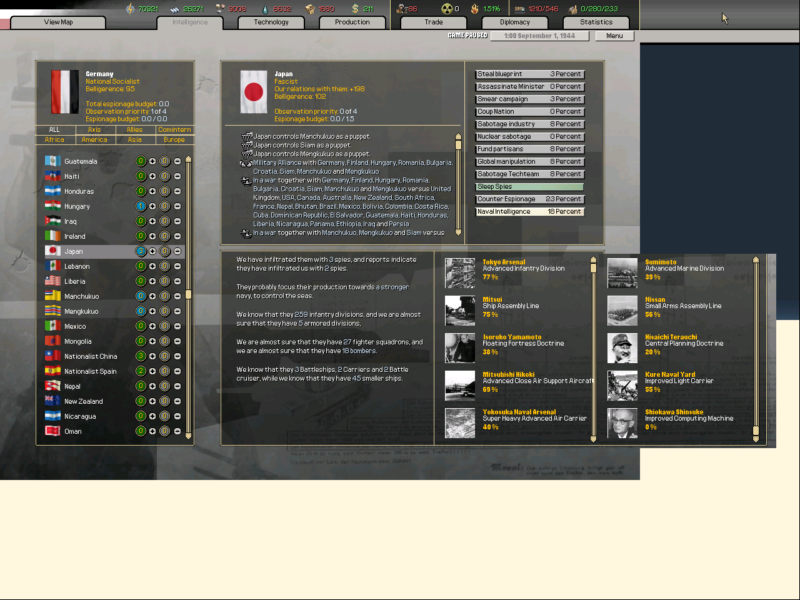
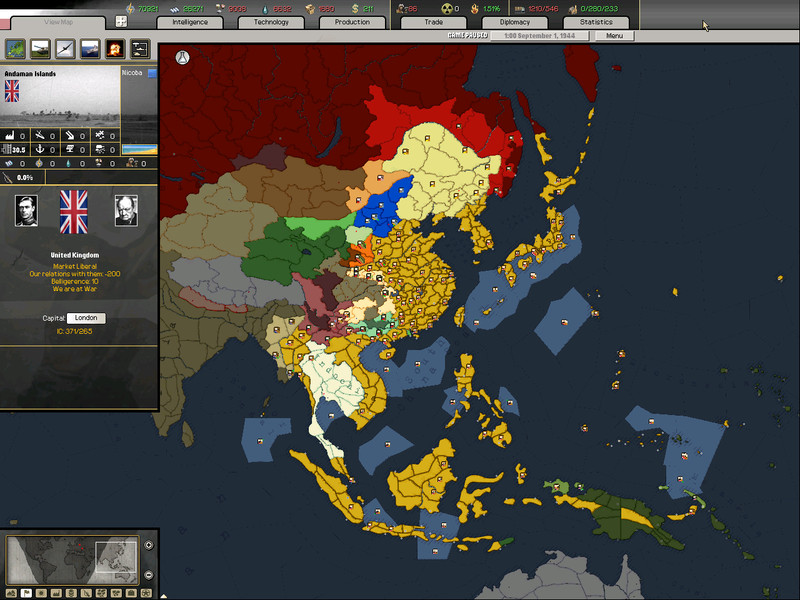
Here are the details. Almost from the instant that Hitler was incapacitated, the Imperial Japanese Navy took a one sided beating. Here are the ship losses through the start of Operation Luttich.
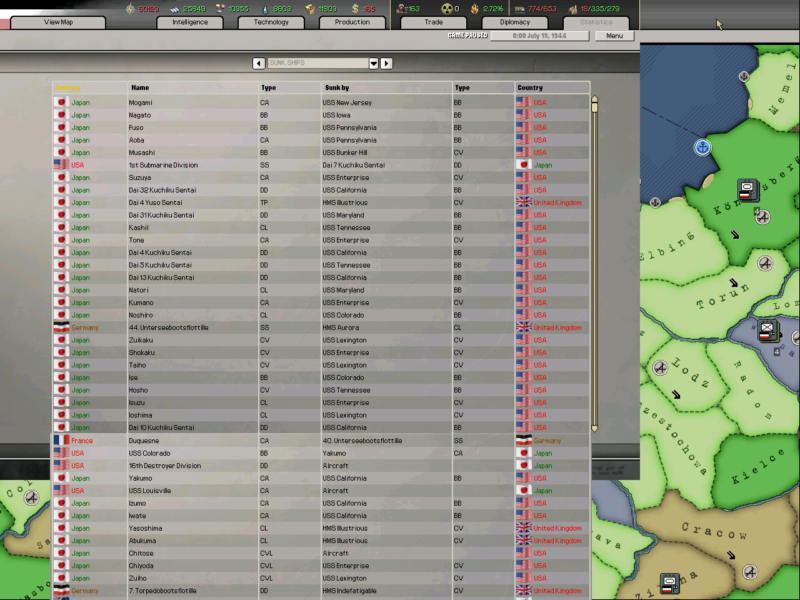
Yes, that is correct. Four battleships, four carriers and three escort carriers, all lost within a 30 day period. Now here are the losses since that time.
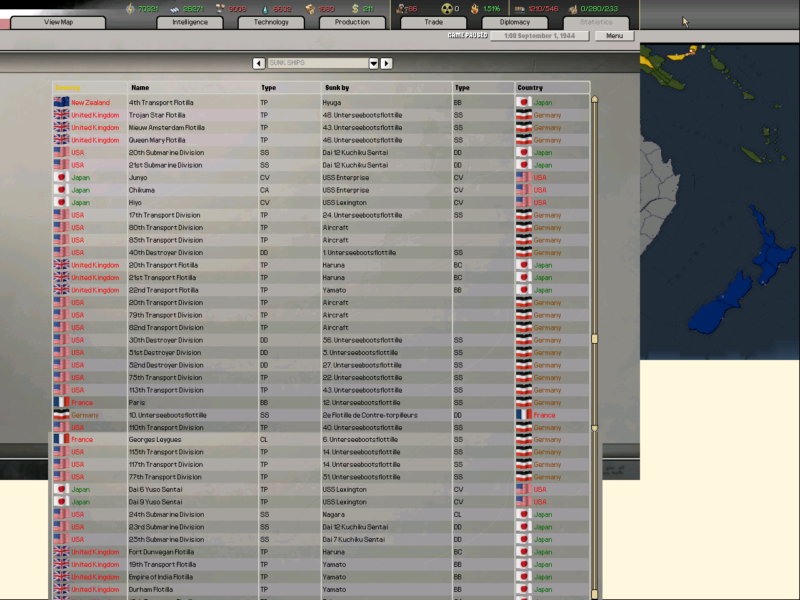
Two more fleet carriers gone, before July was even over. The IJN is a shell already. Their armies ashore will very soon be cut off and doomed at this rate.”
Speer concludes, “So the Pacific war could be over soon. We must redouble our efforts and keep pressing forward. We have survived June and July and August and improved our position in the West. Now we face September and the challenge in the South. Let’s get to work.”
***********************************
Chancellery
September 1, 1944
There are a few small smiles around the conference table as the attendees greet one another and settle into their seats. After all, one very immediate threat to the Fatherland had been removed, at least for the moment. Still, as Chancellor Speer moved to the head of the table, the room grew somber again. The situation was still very grim.
“We are all aware of the magnificent performance of the Wehrmacht in the West. The Volk have rejoiced at this reprieve from the Allied menace. This was work well done.”
“And to you as well, Albert,” pipes up Guderian, “you got enough men and material together to allow the Heer to make that stand.”
“Thank you, Heinz. It was indeed a case of everyone pulling their weight. Now, we have some time to wait, as the re-deployment of troops from the West to other theaters has completely overwhelmed our diminished transportation grid. Martin?”
“Yes, Albert, we will not achieve even the level of “seriously overburdened” transportation network until September 20th or so. As regards other resources, we can support the limited production we have remaining (at this Air Marshal Milch tightens his lips). Our manpower is only available by disbanding divisions that are no longer battle worthy. This will be the case for months to come.”
Seeing his cue, General Jodl rises. “The Heer is giving ground in the East. We have raised a new line just east for Konigsberg. It is even money whether it can be held there. The divisions from the West cannot arrive too soon.
The forces for Operation Stiefelschlacht in Italy are in place, regaining organization and replacing their losses. They will be fully ready in one week but we must wait a bit until we have some hope of resupplying them. We suspect that Allied stockpiles will be out of reach in Sicily, so we have little expectation of succor in that regard. I do have one gambit that Rommel has whispered to me, but that can be discussed at a later date.”
The Air Marshal is looking haggard as he begins. “All bombers remain grounded, without repairs or upgrading. All dogfighters are being reinforced and a few have been upgraded to the Komet aircraft. We are now having some success in the skies over central Germany, but we cannot expand operations outward at this point. I am hopeful that the Allied airbases in Italy can be overrun, just to back them off of the relentless strikes on southern Germany. That’s all”
Admiral Doenitz rises briefly. “We are shelling Riga in support of HG Nord, and we are moving troops from west to east. All surface craft are 100% repaired and all U-boats are repairing in port at this time. We have two U-boat flotillas in the Med, which will follow any orders in support of Heersgruppe Mittelmeer.”
Kaltenbrunner takes the stage. “Here are the reports that the Abwehr has prepared. The enemy INTSUM or intelligence summary are liable to be wildly inaccurate with the limited resources we have in place at this time. We will improve this performance if and when we can fund new recruitment.
First up is the Soviet Union. Their army is massive and their navy is miniscule. The figures for their air force seem exaggerated, though they are plentiful enough. Few of their divisions are at full strength.

The next foe is the United Kingdom. We once had them on their knees but they retain an impressive fleet.

And there is the United States. They are now unrivalled at sea and in the air, but their ground forces are not as numerous. They can replace losses faster than we have been able to inflict them though.

Our ally Japan is struggling. They are advancing in China and falling back in Burma. If you will note their fleet size, it is clear that they have been mauled at sea.


Here are the details. Almost from the instant that Hitler was incapacitated, the Imperial Japanese Navy took a one sided beating. Here are the ship losses through the start of Operation Luttich.

Yes, that is correct. Four battleships, four carriers and three escort carriers, all lost within a 30 day period. Now here are the losses since that time.

Two more fleet carriers gone, before July was even over. The IJN is a shell already. Their armies ashore will very soon be cut off and doomed at this rate.”
Speer concludes, “So the Pacific war could be over soon. We must redouble our efforts and keep pressing forward. We have survived June and July and August and improved our position in the West. Now we face September and the challenge in the South. Let’s get to work.”
***********************************
@ Barvinok The operation is coming right up. The TC level was just unsupportable for a few days. The Luftwaffe upgrades are available with Turbojet Interceptor almost done researching. So much IC has been lost to bombing that upgrades are not getting much attention yet, but that is coming soon.
Redeployment
September 2, 1944
With 40 infantry divisions filling every rail car in the Reich, it is a logistics nightmare. Everything seems to move in slow motion. FM Rommel is extremely grateful that his Panzerkorps was able to ship via sea along the Baltic. As one of the rare formations at full strength and organization, the Korps was a godsend to HG Nord and von Rundstedt sent him immediately forward.

FM Model handed the Soviets another defeat in Iasi. With all of his army groups severely understrength, he was forced to rotate them in and out of theater as often as possible.
The Luftwaffe finally managed to intercept the bombers that were hitting Stuttgart daily and give them enough damage to ground them for some time.
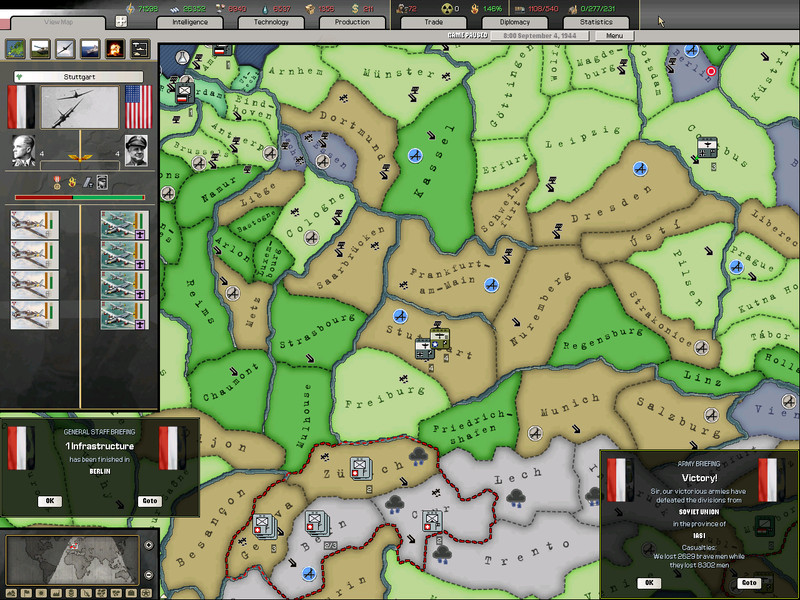
FM von Rundstedt received six infantry divisions and a small mobile corps from France, and just in the nick of time, as the Red Army made a full assault on Jelgava. Perhaps the Soviet leader wished to strike before the new men could dig in. Von Rundstedt immediately began maneuvering against them, as well as gaining mastery in these dank northern forests.
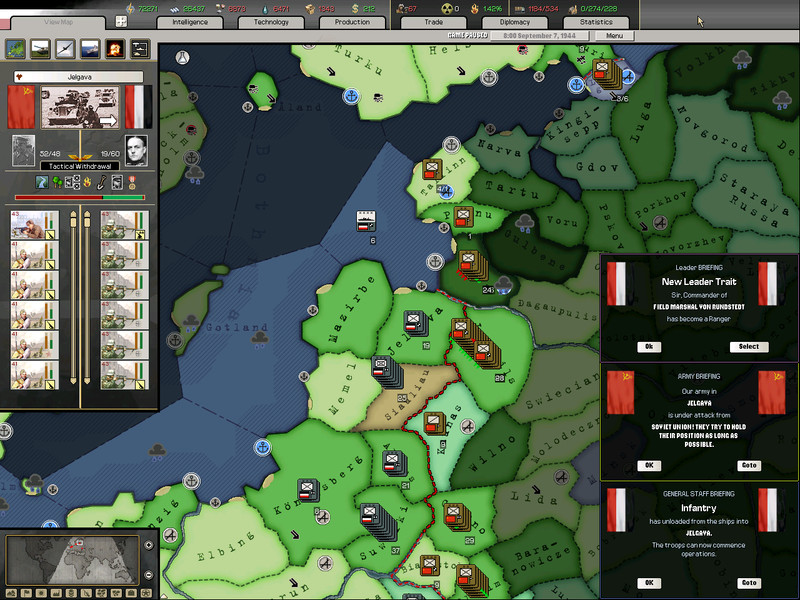
There is no rest in HG Sud, as fresh armies assail Iasi yet again.
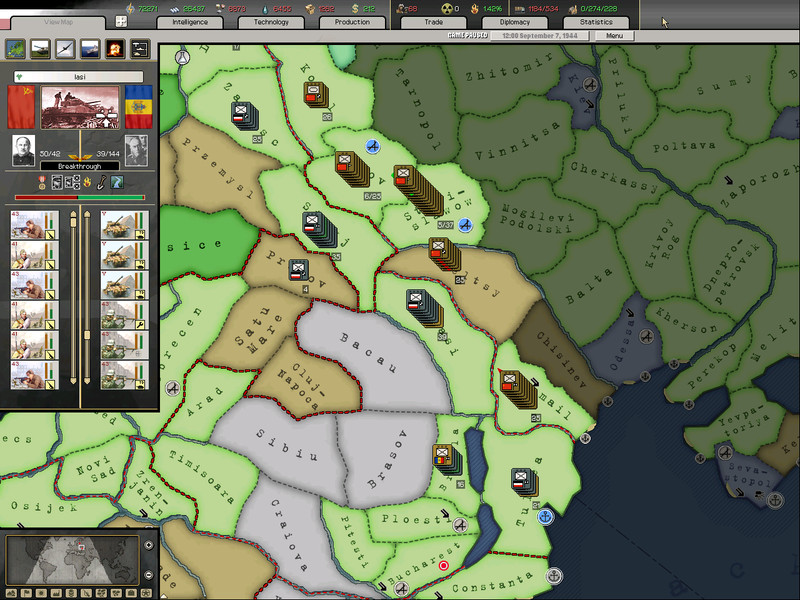
Additional mobile forces arrive to bolster Jelgava and von Rundstedt puts them through their paces, frustrating his opponents time and again. The Kriegsmarine joins in, bombarding Riga day and night.
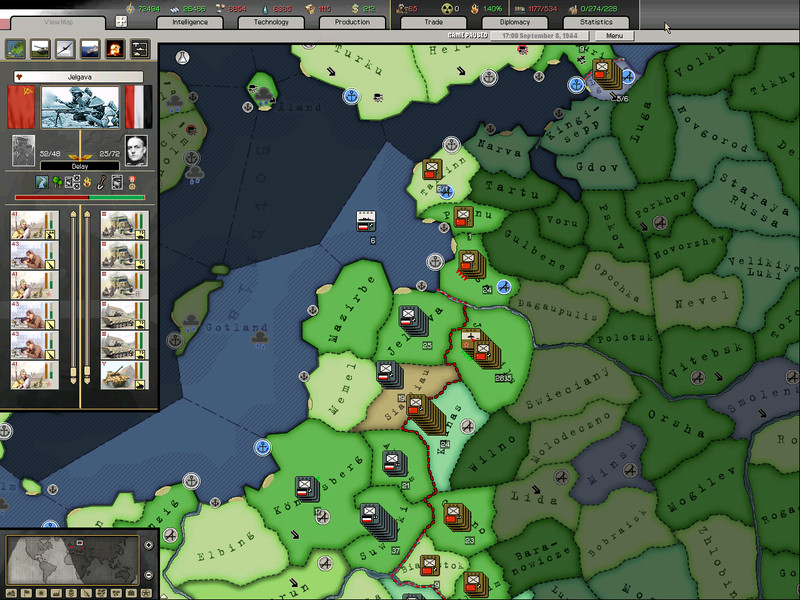
HG Nord uses another from their bag of tricks, as word comes in from FM Model that he is holding and beginning to inflict some serious casualties on those coming at his lines.
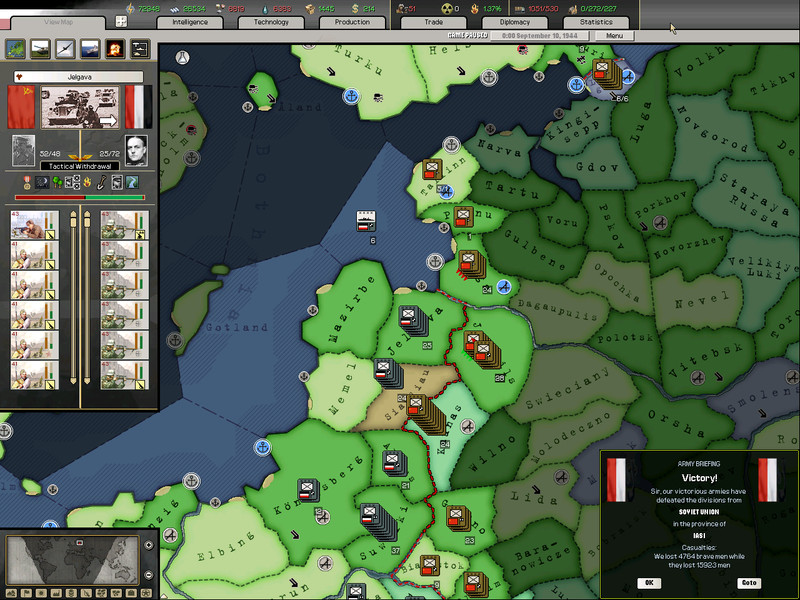
The Luftwaffe enjoys a rare matchup in their favor. Every victory is vital, as the industrial base has been bombed so very low.
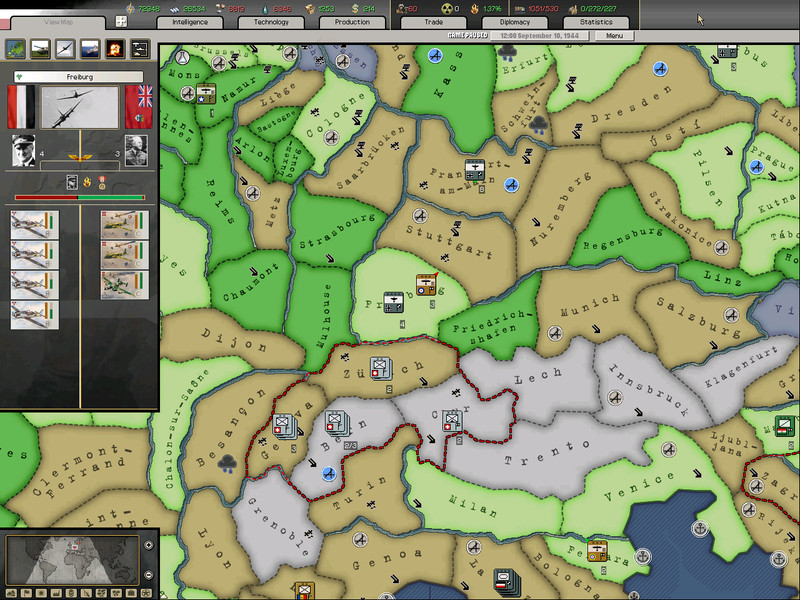
Another valuable interception, though this interceptor wing would need repairs as well. Word arrives of another victory in Jelgava.

The High Command goes into full conference, laden with maps and tables of organization. When they emerge, a flurry of orders is sent to units along the Gustav Line. Operation Stiefelschlacht is approved!
September 2, 1944
With 40 infantry divisions filling every rail car in the Reich, it is a logistics nightmare. Everything seems to move in slow motion. FM Rommel is extremely grateful that his Panzerkorps was able to ship via sea along the Baltic. As one of the rare formations at full strength and organization, the Korps was a godsend to HG Nord and von Rundstedt sent him immediately forward.

FM Model handed the Soviets another defeat in Iasi. With all of his army groups severely understrength, he was forced to rotate them in and out of theater as often as possible.
The Luftwaffe finally managed to intercept the bombers that were hitting Stuttgart daily and give them enough damage to ground them for some time.

FM von Rundstedt received six infantry divisions and a small mobile corps from France, and just in the nick of time, as the Red Army made a full assault on Jelgava. Perhaps the Soviet leader wished to strike before the new men could dig in. Von Rundstedt immediately began maneuvering against them, as well as gaining mastery in these dank northern forests.

There is no rest in HG Sud, as fresh armies assail Iasi yet again.

Additional mobile forces arrive to bolster Jelgava and von Rundstedt puts them through their paces, frustrating his opponents time and again. The Kriegsmarine joins in, bombarding Riga day and night.

HG Nord uses another from their bag of tricks, as word comes in from FM Model that he is holding and beginning to inflict some serious casualties on those coming at his lines.

The Luftwaffe enjoys a rare matchup in their favor. Every victory is vital, as the industrial base has been bombed so very low.

Another valuable interception, though this interceptor wing would need repairs as well. Word arrives of another victory in Jelgava.

The High Command goes into full conference, laden with maps and tables of organization. When they emerge, a flurry of orders is sent to units along the Gustav Line. Operation Stiefelschlacht is approved!
Operation Stiefelschlacht
September 12, 1944
Field Marshal von Kuchler draws the unenviable task of attacking the dug-in UK forces in Rome. His orders are to fix them in place and wear them down, hopefully drawing reinforcements out of their fortifications to the east. He attacks at dawn with 17 divisions in echelon, against 6 UK divisions.
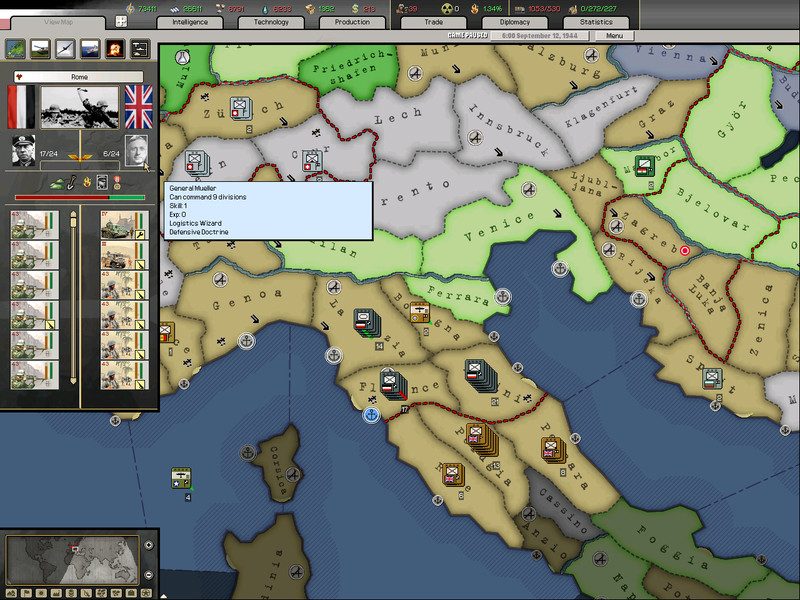
The plan is working thus far. Two Allied divisions move into Rome and take up hasty defensive positions where they are immediately ambushed.
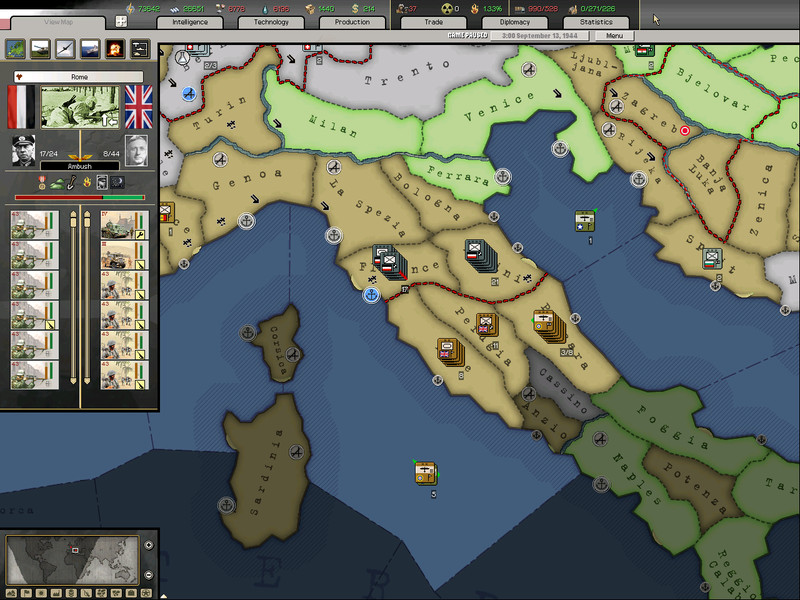
By the 14th many of the Desert Rats are moving towards Rome and FM Von Kluge begins his next maneuver, pouring in the mobile forces against the Brits moving thru Perugia.
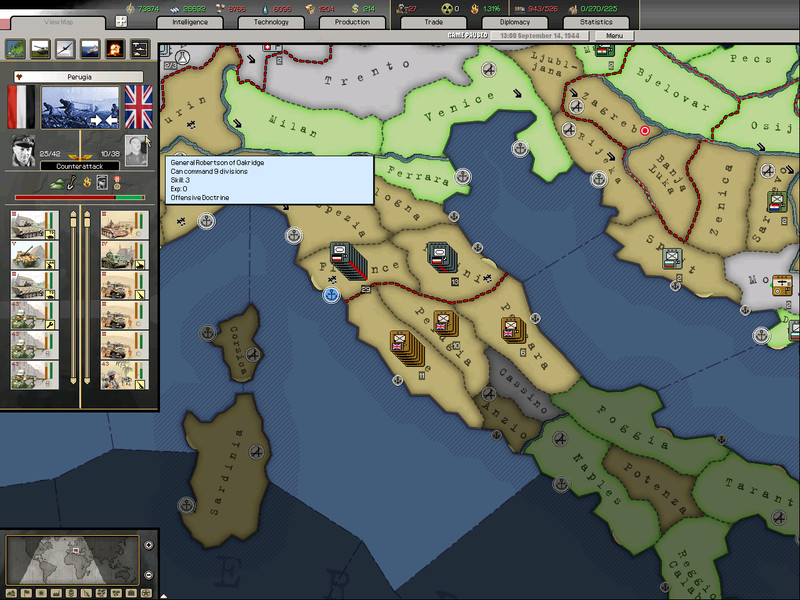
The Red Army seeks to take advantage of the distraction in Italy and attacks Iasi again. Minister von Ribbentrop is shaken to learn that another Mideast power has joined the alliance against Germany.
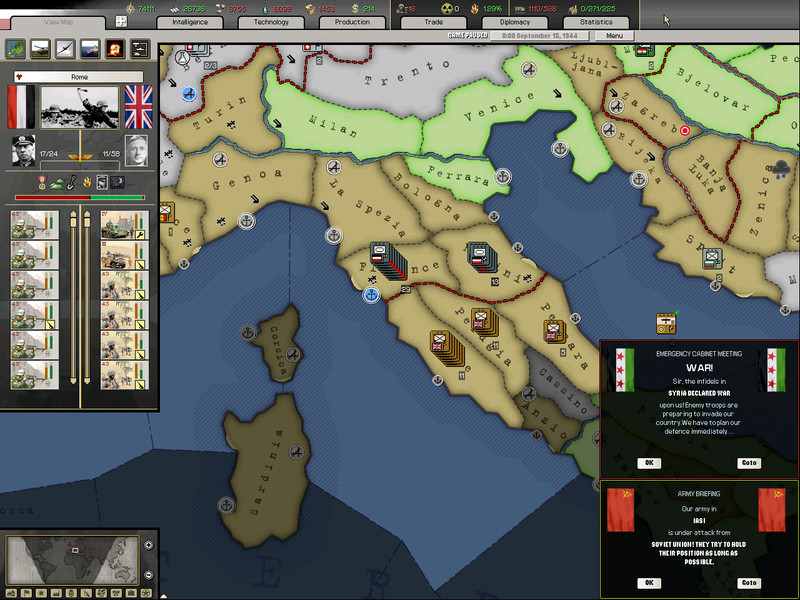
FM Model inflicts another sharp rebuke to the soviets in Iasi. In Italy the defense in Perugia is spent. The Allied commander cannot divert forces from Rome and has elected to keep five divisions in Pescara.
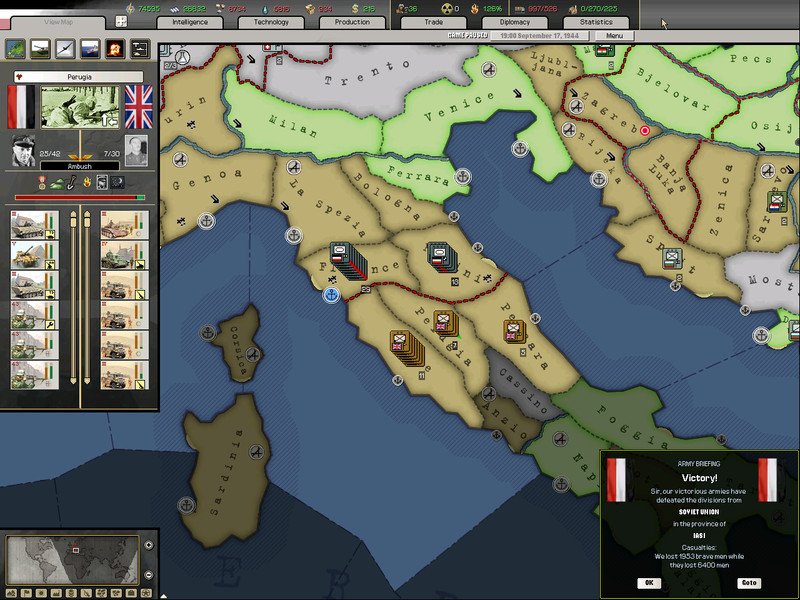
Perugia falls in a bloody exchange, opening the way for encirclements of both wings of the British defense. FM von Kuchler keeps his tired troops at it as the Panzerkorps sweep south.
On the Ostfront, the last positions east of the Bug River are abandoned.
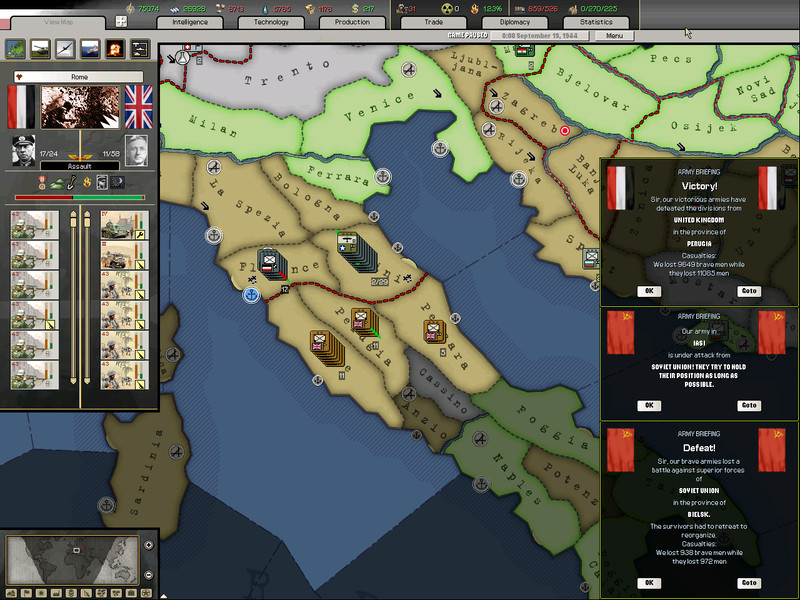
(Author’s note, I was forced to restart a crashed game on the 19th so the casualty figures for Rome and Iasi are quite skewed.)
The British lines are pierced and the Heer pushes everything they can into the gap.
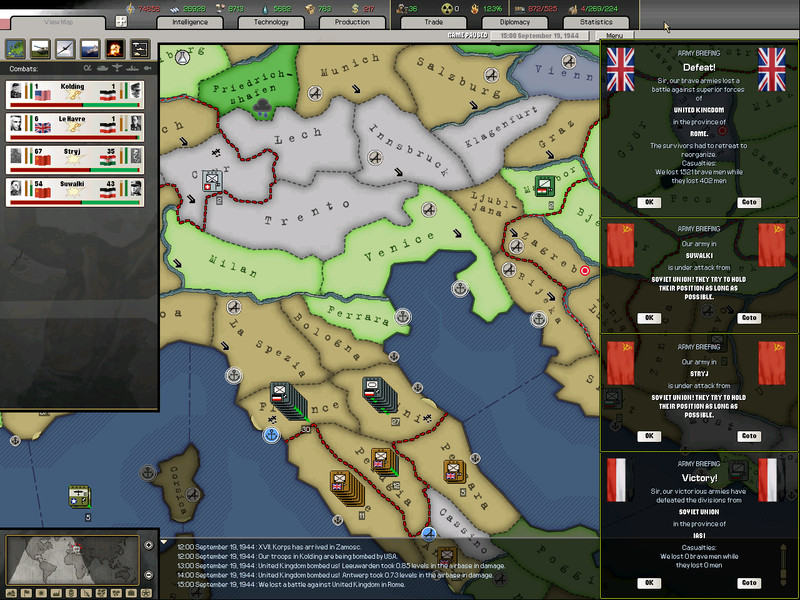
The Red Army pushed in Suwalki but HG Nord is equal to the task. FM von Rundstedt does make plans to replace FM Busch with a more defensive oriented commander at first opportunity.

Anzio is overrun as FM Dietl fixes the UK forces in Rome yet again. The trap is nearly closed on them.
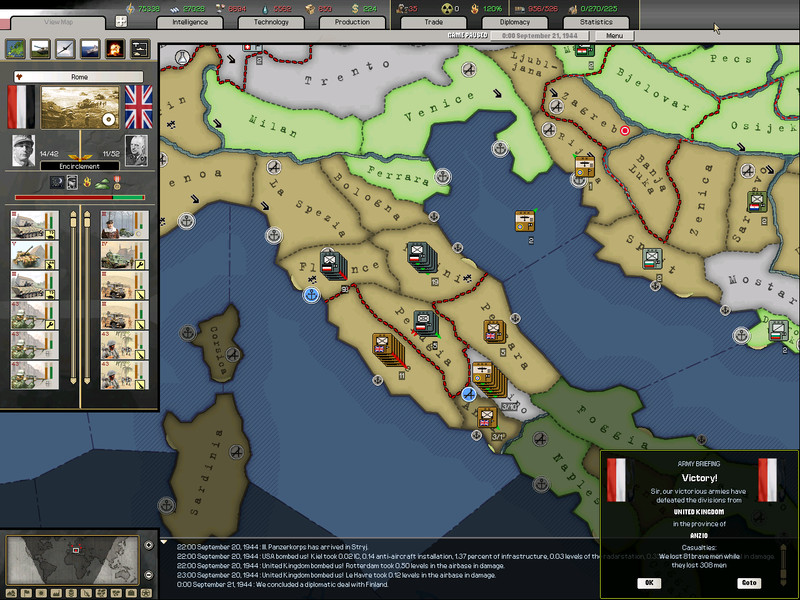
FM Busch is holding firm.
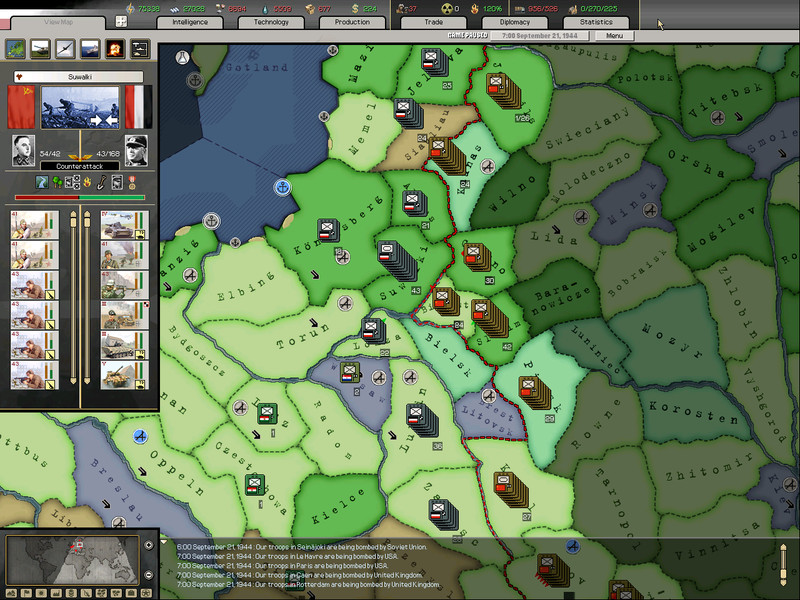
The door slams on the forces in Rome, and a swarm of Allied aircraft is forced to flee the airbase in Anzio. They find no refuge in Naples which immediately is targeted by the advancing columns.
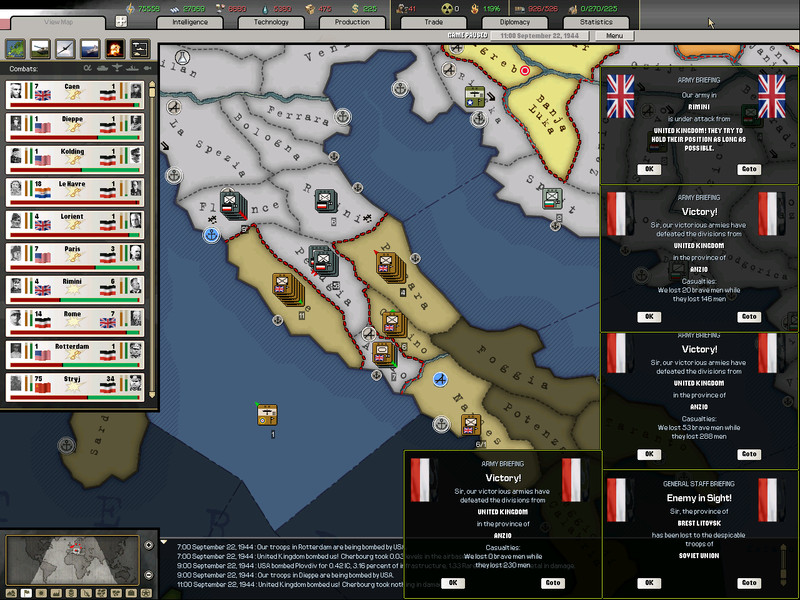
The Allies in Rome are overrun. There is no telling if any of them escaped via sea. FM List continues to thwart STAVKA’s efforts in Stryj.
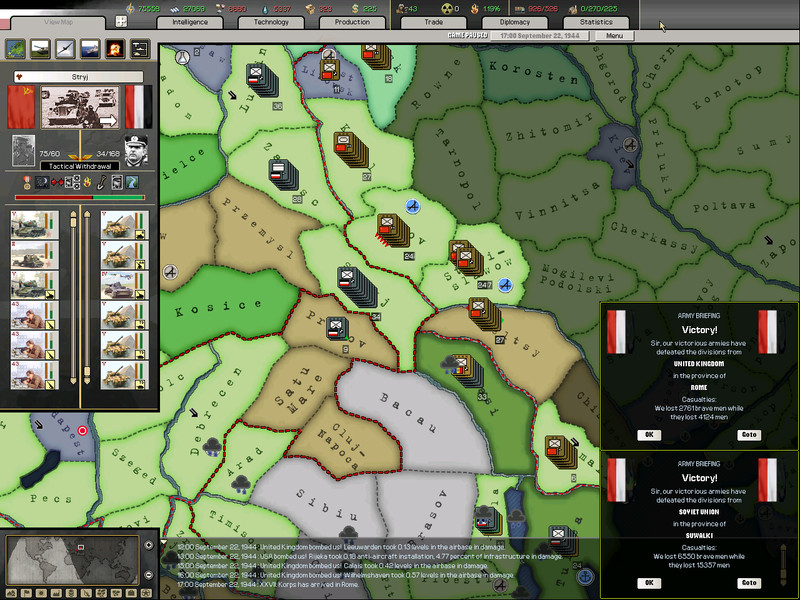
The Brits make a stand in Naples but are quickly routed, forcing their aircraft to flee yet again. Hopefully some are being destroyed on the ground. FM von Kluge prepares a special project that may pay off a little further south.
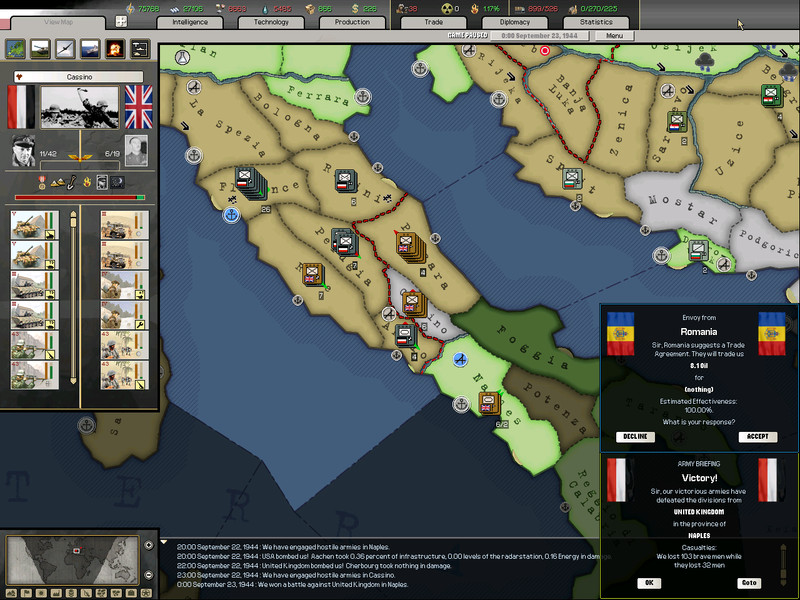
The Allies reel backwards all across the Italian peninsula, unable to hold any ground against the Heer. FM List continues to out maneuver his opponents.
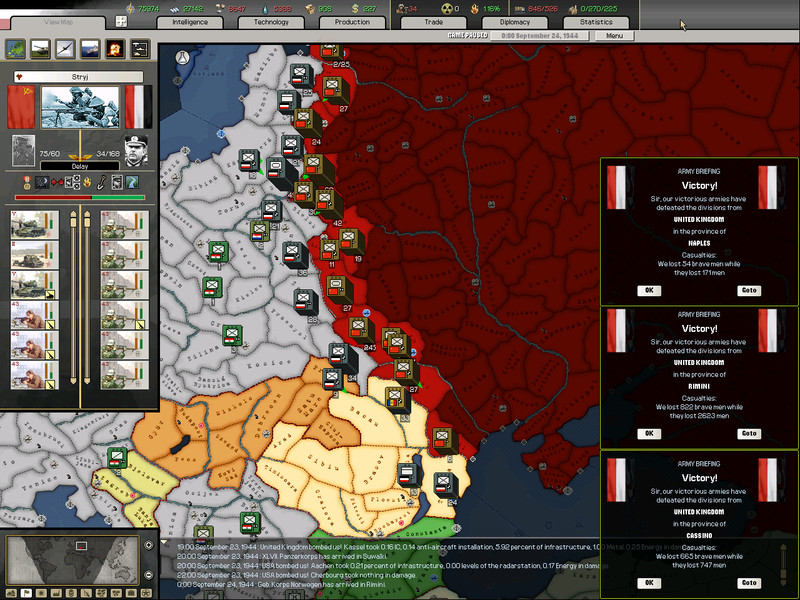
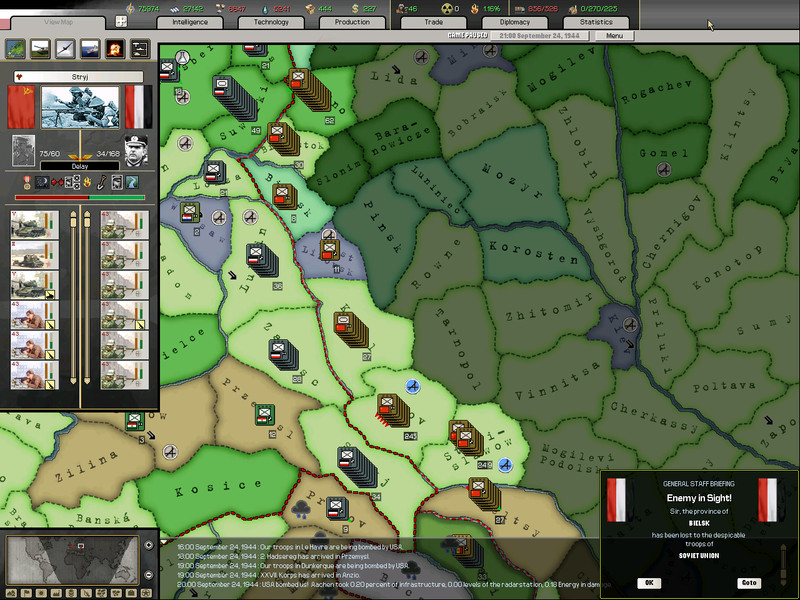
Halted in Stryj, STAVKA pressures the defense in Suwalki again, seeking some breakthrough before the ground freezes. The Luftwaffe rises to the occasion over Hannover, damaging and driving off some American strategic bombers. These bombers are crippling Germany and all efforts are going to stop their depredations.

The UK’s supply depot is located in Palermo, easily blocked by Allied ships of war. Nonetheless the attempt must be made and XIV Panzerkorps attempts to overrun the province before he can be stopped.
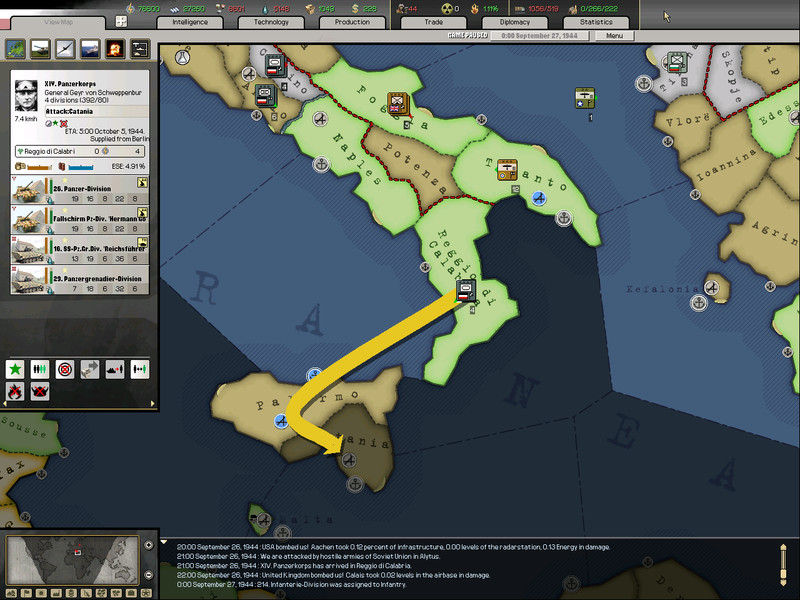
FM von Kluge resolutely marches south and east, clearing the peninsula of any and all Allied forces.
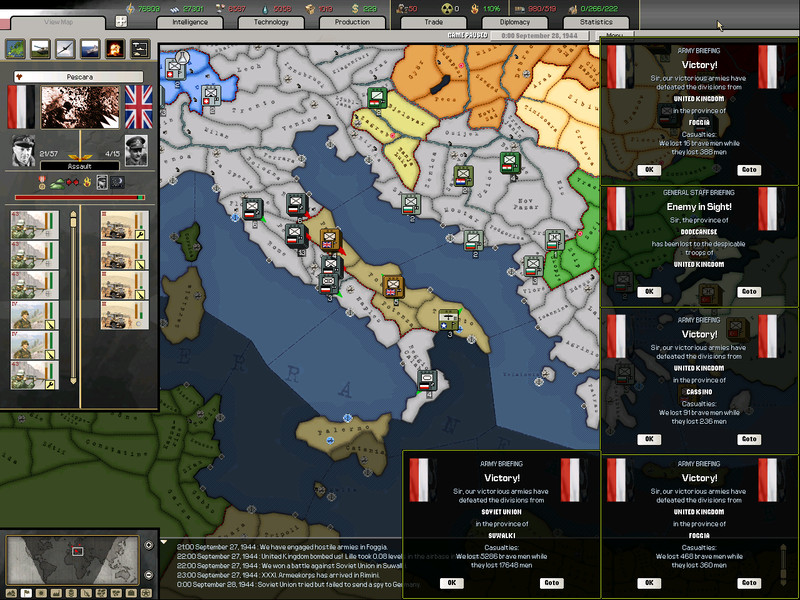
HG Nord is tested in Alytus for a change. The Wehrmacht here has engineer support and is dug in tight, like a tick on a dog. In the south, German divisions eliminate many small pockets of Commonwealth forces in rapid succession.

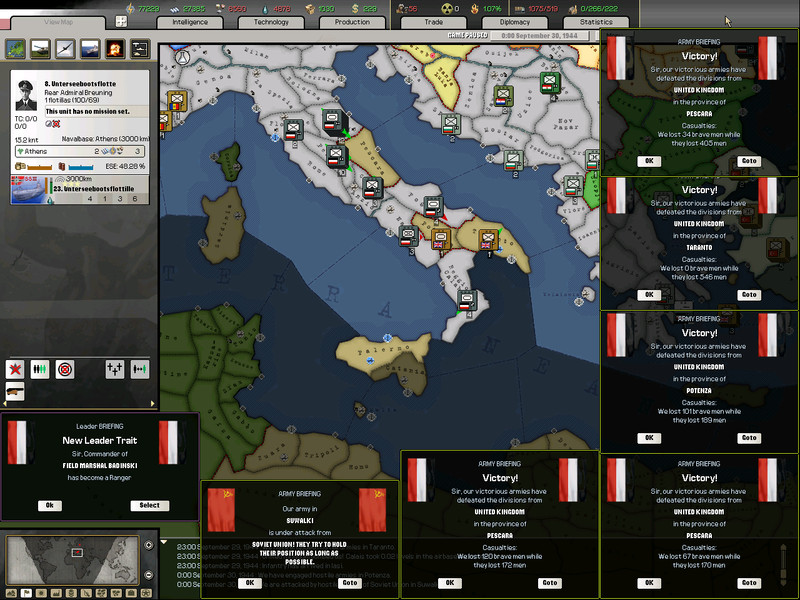
The Red Army tries Suwalki again, though their own forces are beginning to show the strain. The UK continues to snap up the islands in the Med, which the German High Command in general ignores.
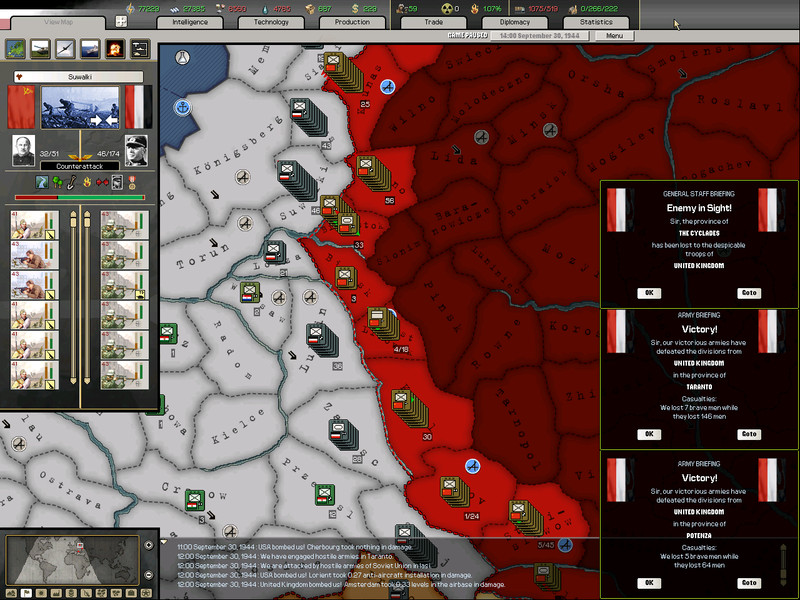
FM von Kluge’s main effort to capture the largest of the supply dumps in Italy founders as Allied shipping blocks the Panzerkorps from crossing to Palermo. He decides to try his ruse on the British Command. The Panzerkorps is ordered to drive north, leaving one division in place, masked by a Trickster leader. This division will make an attempt to sneak across.
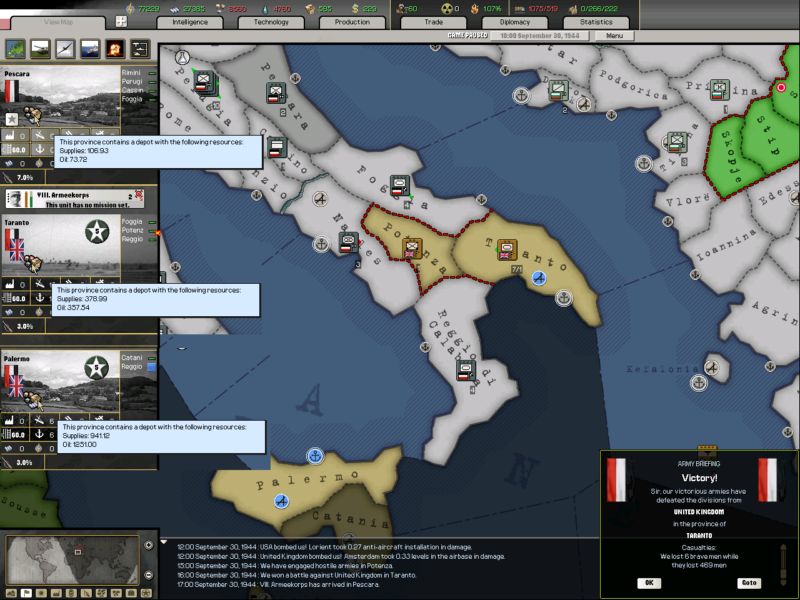
The “boot” of Italy is restored to the Reich. Already the factories in the Balkans and northern Italy welcome the absence of marauding bombers in their skies.
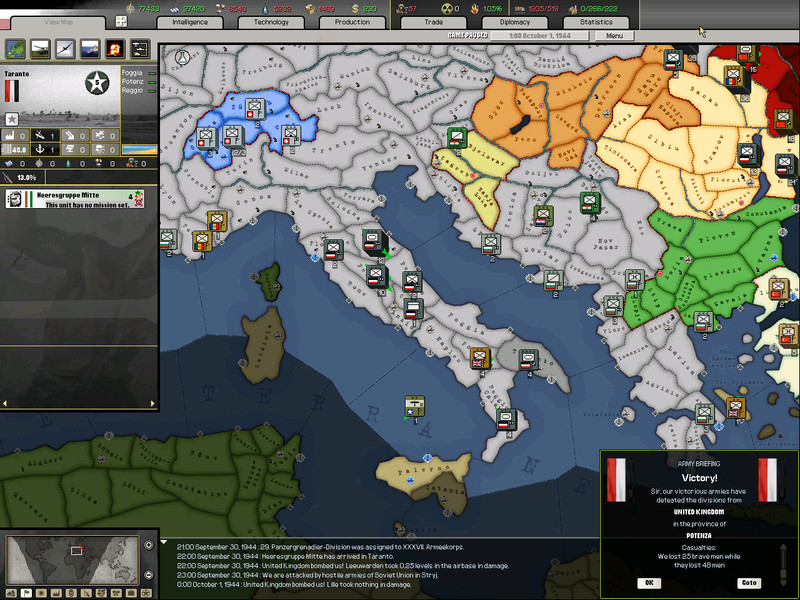
Another successful defense against the Red Army. The secondary line appears to be holding, and the casualties for the Soviets are mounting!
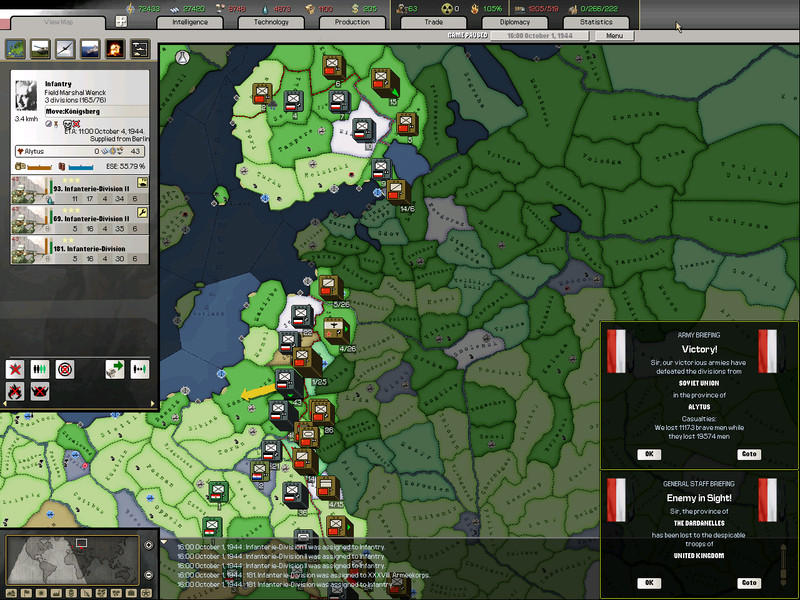
September 12, 1944
Field Marshal von Kuchler draws the unenviable task of attacking the dug-in UK forces in Rome. His orders are to fix them in place and wear them down, hopefully drawing reinforcements out of their fortifications to the east. He attacks at dawn with 17 divisions in echelon, against 6 UK divisions.

The plan is working thus far. Two Allied divisions move into Rome and take up hasty defensive positions where they are immediately ambushed.

By the 14th many of the Desert Rats are moving towards Rome and FM Von Kluge begins his next maneuver, pouring in the mobile forces against the Brits moving thru Perugia.

The Red Army seeks to take advantage of the distraction in Italy and attacks Iasi again. Minister von Ribbentrop is shaken to learn that another Mideast power has joined the alliance against Germany.

FM Model inflicts another sharp rebuke to the soviets in Iasi. In Italy the defense in Perugia is spent. The Allied commander cannot divert forces from Rome and has elected to keep five divisions in Pescara.

Perugia falls in a bloody exchange, opening the way for encirclements of both wings of the British defense. FM von Kuchler keeps his tired troops at it as the Panzerkorps sweep south.
On the Ostfront, the last positions east of the Bug River are abandoned.

(Author’s note, I was forced to restart a crashed game on the 19th so the casualty figures for Rome and Iasi are quite skewed.)
The British lines are pierced and the Heer pushes everything they can into the gap.

The Red Army pushed in Suwalki but HG Nord is equal to the task. FM von Rundstedt does make plans to replace FM Busch with a more defensive oriented commander at first opportunity.

Anzio is overrun as FM Dietl fixes the UK forces in Rome yet again. The trap is nearly closed on them.

FM Busch is holding firm.

The door slams on the forces in Rome, and a swarm of Allied aircraft is forced to flee the airbase in Anzio. They find no refuge in Naples which immediately is targeted by the advancing columns.

The Allies in Rome are overrun. There is no telling if any of them escaped via sea. FM List continues to thwart STAVKA’s efforts in Stryj.

The Brits make a stand in Naples but are quickly routed, forcing their aircraft to flee yet again. Hopefully some are being destroyed on the ground. FM von Kluge prepares a special project that may pay off a little further south.

The Allies reel backwards all across the Italian peninsula, unable to hold any ground against the Heer. FM List continues to out maneuver his opponents.


Halted in Stryj, STAVKA pressures the defense in Suwalki again, seeking some breakthrough before the ground freezes. The Luftwaffe rises to the occasion over Hannover, damaging and driving off some American strategic bombers. These bombers are crippling Germany and all efforts are going to stop their depredations.

The UK’s supply depot is located in Palermo, easily blocked by Allied ships of war. Nonetheless the attempt must be made and XIV Panzerkorps attempts to overrun the province before he can be stopped.

FM von Kluge resolutely marches south and east, clearing the peninsula of any and all Allied forces.

HG Nord is tested in Alytus for a change. The Wehrmacht here has engineer support and is dug in tight, like a tick on a dog. In the south, German divisions eliminate many small pockets of Commonwealth forces in rapid succession.


The Red Army tries Suwalki again, though their own forces are beginning to show the strain. The UK continues to snap up the islands in the Med, which the German High Command in general ignores.

FM von Kluge’s main effort to capture the largest of the supply dumps in Italy founders as Allied shipping blocks the Panzerkorps from crossing to Palermo. He decides to try his ruse on the British Command. The Panzerkorps is ordered to drive north, leaving one division in place, masked by a Trickster leader. This division will make an attempt to sneak across.

The “boot” of Italy is restored to the Reich. Already the factories in the Balkans and northern Italy welcome the absence of marauding bombers in their skies.

Another successful defense against the Red Army. The secondary line appears to be holding, and the casualties for the Soviets are mounting!

good progress, just hope you don't get nuked so keep those int's patrolling. Once you move East will you try to attack in the North through the high TC provinces or in the south which are amenable to panzers?
@ Sandertje France and Italy are indeed secured for the moment. The Ostfront and the Allied bombing campaign are a very tough combination though.
@ clist123abc I am not at all sure of the next step in the East. In this mod the Soviets have more divisions than usual and they seem to be slowly moving south. My first concern is to hold the line and get the Luftwaffe back into the fight. That might take the whole winter with the IC that I have remaining.
To all: I apologize for the snail's pace. I unexpectedly had to find new lodgings and I am moving this week.
@ clist123abc I am not at all sure of the next step in the East. In this mod the Soviets have more divisions than usual and they seem to be slowly moving south. My first concern is to hold the line and get the Luftwaffe back into the fight. That might take the whole winter with the IC that I have remaining.
To all: I apologize for the snail's pace. I unexpectedly had to find new lodgings and I am moving this week.
Heersgruppe Mittemeer Headquarters, Milan
October 1, 1944
Chancellor Speer begins: “We are meeting here in order to demonstrate a clear and undeniable change that has been affected for the Reich. I call your attention to the window there, which is wide open. If you listen you can hear saws and hammers and some truck traffic. I passed through here three weeks ago and heard little but AA guns firing and massive detonations as the Allies rained down destruction on the industrial areas night and day. The rebuilding effort here will take some time, of course, but the decline has at least been halted. That is how I wished to begin this meeting, on a clear note of success. Defense Minister, please update all of us on the present situation.”
All eyes shift to General Jodl. “Good morning, everyone. And it is a good morning. The flag of the Fatherland rises every day over Taranto now, and Rome, and Brest. The Allies maintain a toehold in Sicily, but are otherwise driven out of the European mainland. The fight in Rome was a brutal one, but Field Marshal von Kluge’s operational plan was sound and he executed it brilliantly. The Commonwealth forces were thrown quickly onto their back foot and were not allowed to recover. With no air cover or significant naval assets in the area, we are uncertain as to how many Allied divisions may have been successfully evacuated, but we do know that about 17 divisions worth of casualties were inflicted on the British and American forces in Italy, as will be seen in the Abwehr’s report. In similar fashion, we cannot ascertain whether any or all of the Allied air units were overrun in Anzio, Naples and Taranto, but the bombing runs along our Mittemeer coast have dropped to zero at present, so they are at the least being forced to make extensive repairs. Operation Stiefelschlacht is for all intents complete, but we are leaving the operation active for a few more days, as we do have one division making a clandestine attempt on Palermo. There is a risk of loss if Allied ships cut him off there, but the supply depot, airfield and port facilities are too tempting a target for us to ignore.
Here are the reports on casualties. We can ill afford them, but we are inflicting from 2-5 times our losses to the Soviets and that should be very difficult for even the Russians to sustain over time. The Heer is redeploying east from the Italian peninsula, so our transport system will once more be overwhelmed, but this should be the last massive movement for quite some time, so we can look forward to that. General Hoepner?
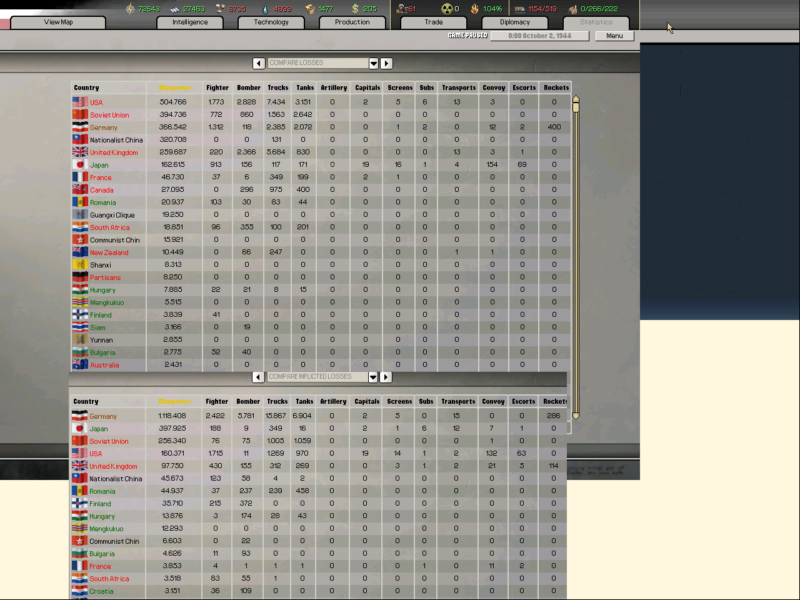
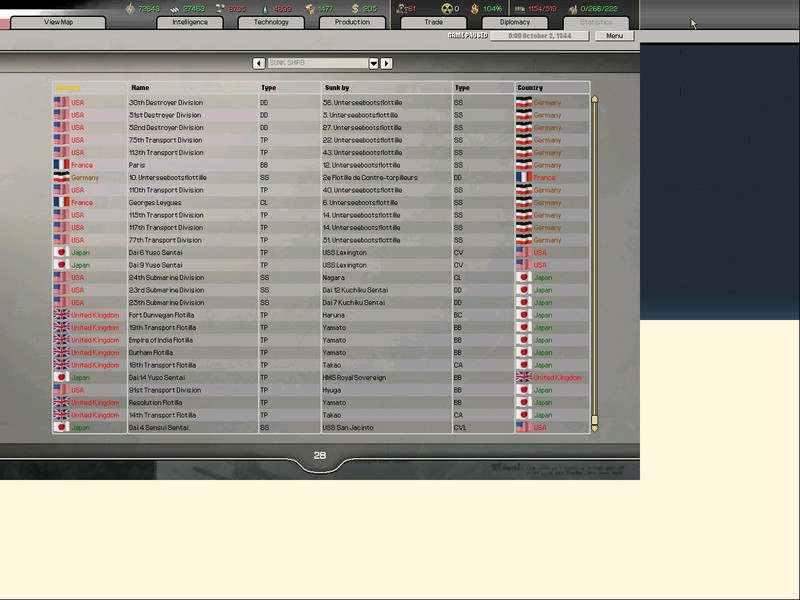
“The Heer is reducing activity to minimum levels, holding the front lines and coast lines, in accordance with the Chancellor’s directives. We are moving armies around in preparation for several initiatives when the time is ripe for them. The Red Army must pay a butcher’s bill for attacks in the East now. Most infantry formations have engineer support and are fully dug in using forested terrain or behind riverbanks, which are now also deep in snow. The Russians typically attack us with 2 to 1 numerical superiority and then typically suffer several times our losses in consequence. I’d prefer to strike back but we are fully defensive at this time. Karl?”
“The Kriegsmarine is 100% repaired and awaits opportunities. The remaining U-boats stand ready to disrupt any Allied landings on the Atlantic coast. We continue to move troops in the Baltic. That is all I have. Erhard?”
“There is no more time to waste in the skies. All agree that the re-conquests in the West and the South were necessary to eliminate those immediate perils. Now the greatest peril is losing what remains of our battered economy. I cannot defend the Reich with what I have. Albert has assured me an uninterrupted stretch of repairs and upgrades and I will hold him to that. Our plan is to upgrade our most outdated interceptors to our second best version, as this will go rather quickly. Once all are at that level we will complete their upgrades, along with those of our fighter wing, to the turbojet versions we now have developed. This will take months with the reduced allocations now available. With modern aircraft I believe that the Allied and Russian air formations can be held at bay. Their loss of bases in Europe brought immediate relief, but their long range strategic bombers will return soon, and we must meet and defeat them if the Reich is to survive.”
Speer points to Bormann. “Our manpower situation is slightly improved with the addition of Colonel Klink, but we continue to disband divisions to maintain our reinforcement flow. We expect some technology breakthroughs in January in the agriculture and hospital fields and these will help somewhat with this, but we will need every drop we can find. Be sparing where you can, generals.”
“On the diplomatic front,” intones von Ribbentrop, “there is little activity. We do not have many resources to trade, though we are shipping many tons of coal to Japan on an irregular basis. Only about a third is getting through but it is imperative that they be maintained in the war. As you know, Syria joined the war on the Allied side, which is of no concern. When we have some supplies stockpiled again, I will be able to negotiate for more oil and even aircraft for the Luftwaffe. We have signed agreements with our allies to exchange aircraft for 1,000 tons of supplies per aircraft level, which means that we can afford none of them at this time.
Here is a look at our erstwhile allies in the Pacific.
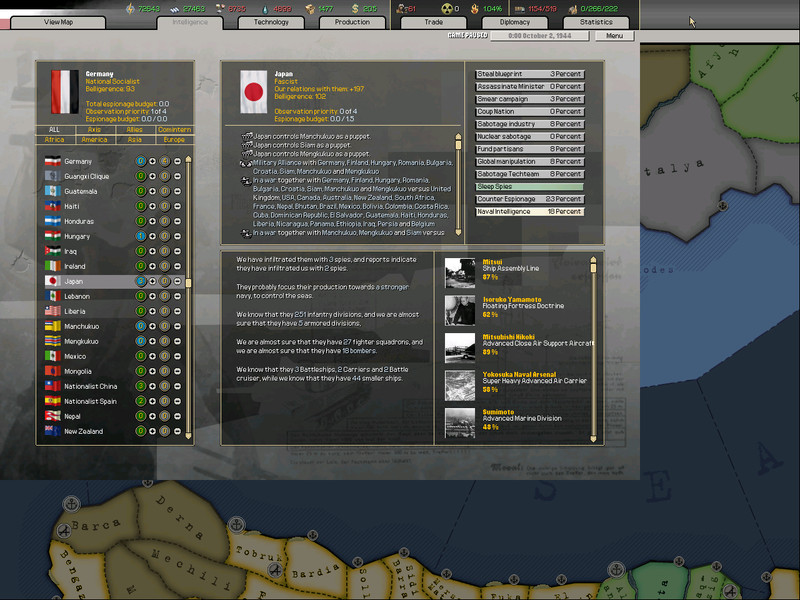
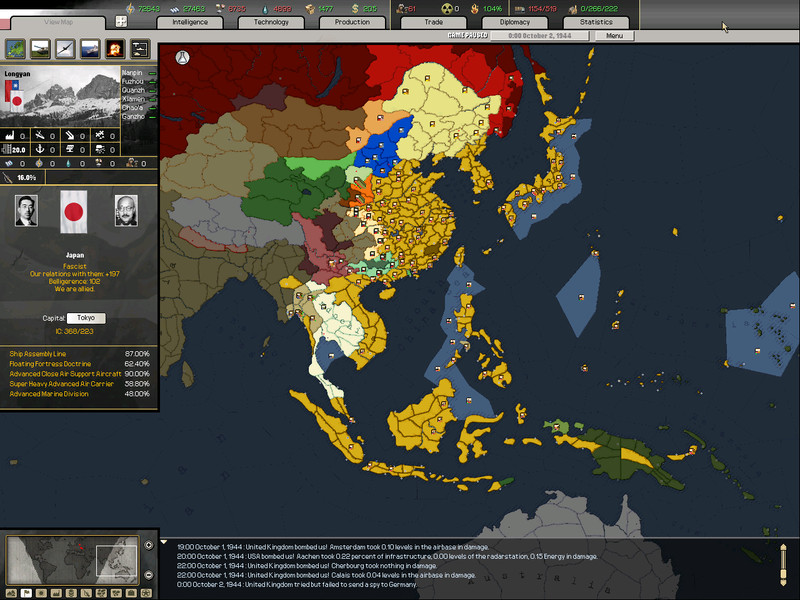
They seem to have stabilized somewhat after a disastrous June and July at sea. They are in danger of losing Siam to the British but are managing well enough in China.”
Kaltenbrunner rises. “Here are the reports gathered by our few agents in Russia, England, and the United States. We can use them as a rough planning guide, nothing more.”

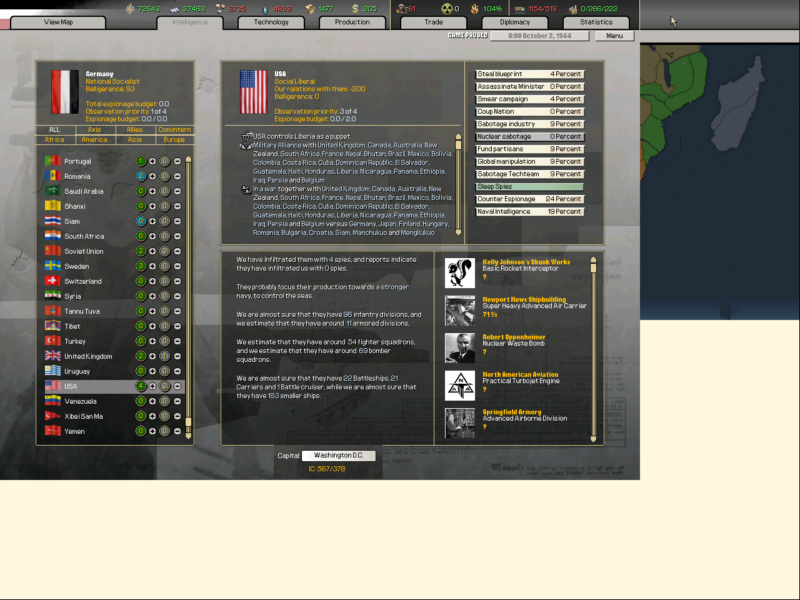
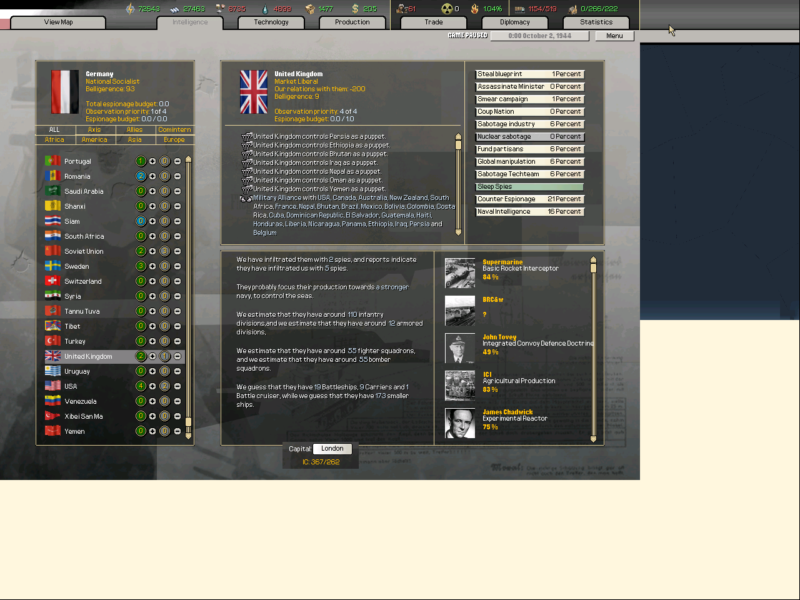
Chancellor Speer takes the floor once more. “The only item we are still producing is the infrastructure in Berlin. For the next few months we will be fighting mainly on the economic front. We must rebuild enough of an industrial base to continue to wage war. First priority is the Luftwaffe, then the factories and road networks. Only then may we resume offensive ground warfare.
Martin and I have had a speech recorded by our former leader which we will play for the populace tomorrow. It is a prepared statement that he has read with his usual invective, regarding our recent triumphs. In this way Hitler can still be useful, even as his misguided policies are put to pasture. That is all.”
October 1, 1944
Chancellor Speer begins: “We are meeting here in order to demonstrate a clear and undeniable change that has been affected for the Reich. I call your attention to the window there, which is wide open. If you listen you can hear saws and hammers and some truck traffic. I passed through here three weeks ago and heard little but AA guns firing and massive detonations as the Allies rained down destruction on the industrial areas night and day. The rebuilding effort here will take some time, of course, but the decline has at least been halted. That is how I wished to begin this meeting, on a clear note of success. Defense Minister, please update all of us on the present situation.”
All eyes shift to General Jodl. “Good morning, everyone. And it is a good morning. The flag of the Fatherland rises every day over Taranto now, and Rome, and Brest. The Allies maintain a toehold in Sicily, but are otherwise driven out of the European mainland. The fight in Rome was a brutal one, but Field Marshal von Kluge’s operational plan was sound and he executed it brilliantly. The Commonwealth forces were thrown quickly onto their back foot and were not allowed to recover. With no air cover or significant naval assets in the area, we are uncertain as to how many Allied divisions may have been successfully evacuated, but we do know that about 17 divisions worth of casualties were inflicted on the British and American forces in Italy, as will be seen in the Abwehr’s report. In similar fashion, we cannot ascertain whether any or all of the Allied air units were overrun in Anzio, Naples and Taranto, but the bombing runs along our Mittemeer coast have dropped to zero at present, so they are at the least being forced to make extensive repairs. Operation Stiefelschlacht is for all intents complete, but we are leaving the operation active for a few more days, as we do have one division making a clandestine attempt on Palermo. There is a risk of loss if Allied ships cut him off there, but the supply depot, airfield and port facilities are too tempting a target for us to ignore.
Here are the reports on casualties. We can ill afford them, but we are inflicting from 2-5 times our losses to the Soviets and that should be very difficult for even the Russians to sustain over time. The Heer is redeploying east from the Italian peninsula, so our transport system will once more be overwhelmed, but this should be the last massive movement for quite some time, so we can look forward to that. General Hoepner?


“The Heer is reducing activity to minimum levels, holding the front lines and coast lines, in accordance with the Chancellor’s directives. We are moving armies around in preparation for several initiatives when the time is ripe for them. The Red Army must pay a butcher’s bill for attacks in the East now. Most infantry formations have engineer support and are fully dug in using forested terrain or behind riverbanks, which are now also deep in snow. The Russians typically attack us with 2 to 1 numerical superiority and then typically suffer several times our losses in consequence. I’d prefer to strike back but we are fully defensive at this time. Karl?”
“The Kriegsmarine is 100% repaired and awaits opportunities. The remaining U-boats stand ready to disrupt any Allied landings on the Atlantic coast. We continue to move troops in the Baltic. That is all I have. Erhard?”
“There is no more time to waste in the skies. All agree that the re-conquests in the West and the South were necessary to eliminate those immediate perils. Now the greatest peril is losing what remains of our battered economy. I cannot defend the Reich with what I have. Albert has assured me an uninterrupted stretch of repairs and upgrades and I will hold him to that. Our plan is to upgrade our most outdated interceptors to our second best version, as this will go rather quickly. Once all are at that level we will complete their upgrades, along with those of our fighter wing, to the turbojet versions we now have developed. This will take months with the reduced allocations now available. With modern aircraft I believe that the Allied and Russian air formations can be held at bay. Their loss of bases in Europe brought immediate relief, but their long range strategic bombers will return soon, and we must meet and defeat them if the Reich is to survive.”
Speer points to Bormann. “Our manpower situation is slightly improved with the addition of Colonel Klink, but we continue to disband divisions to maintain our reinforcement flow. We expect some technology breakthroughs in January in the agriculture and hospital fields and these will help somewhat with this, but we will need every drop we can find. Be sparing where you can, generals.”
“On the diplomatic front,” intones von Ribbentrop, “there is little activity. We do not have many resources to trade, though we are shipping many tons of coal to Japan on an irregular basis. Only about a third is getting through but it is imperative that they be maintained in the war. As you know, Syria joined the war on the Allied side, which is of no concern. When we have some supplies stockpiled again, I will be able to negotiate for more oil and even aircraft for the Luftwaffe. We have signed agreements with our allies to exchange aircraft for 1,000 tons of supplies per aircraft level, which means that we can afford none of them at this time.
Here is a look at our erstwhile allies in the Pacific.


They seem to have stabilized somewhat after a disastrous June and July at sea. They are in danger of losing Siam to the British but are managing well enough in China.”
Kaltenbrunner rises. “Here are the reports gathered by our few agents in Russia, England, and the United States. We can use them as a rough planning guide, nothing more.”



Chancellor Speer takes the floor once more. “The only item we are still producing is the infrastructure in Berlin. For the next few months we will be fighting mainly on the economic front. We must rebuild enough of an industrial base to continue to wage war. First priority is the Luftwaffe, then the factories and road networks. Only then may we resume offensive ground warfare.
Martin and I have had a speech recorded by our former leader which we will play for the populace tomorrow. It is a prepared statement that he has read with his usual invective, regarding our recent triumphs. In this way Hitler can still be useful, even as his misguided policies are put to pasture. That is all.”
Great to see Japan still being alive. This should draw so troops away from the Fatherland.
My apologies to any readers. My move was the usual pain and then the Internet connection was flawed and required three service calls to get remedied. I have begun again and an update follows, but then I will be away for about a week again.
@ TheRealKestral I won't abandon the AAR too easily. The Allies and the Comintern will have to work for it!
@ TheRealKestral I won't abandon the AAR too easily. The Allies and the Comintern will have to work for it!
October 2, 1944
Field Marshal Model continues to hold fast against the Russian hordes in Iasi.

The Red Army pushes also in Stryj, but makes little headway against FM List’s dug in forces. The Soviets halt their drive in Suwalki after taking heavy casualties.
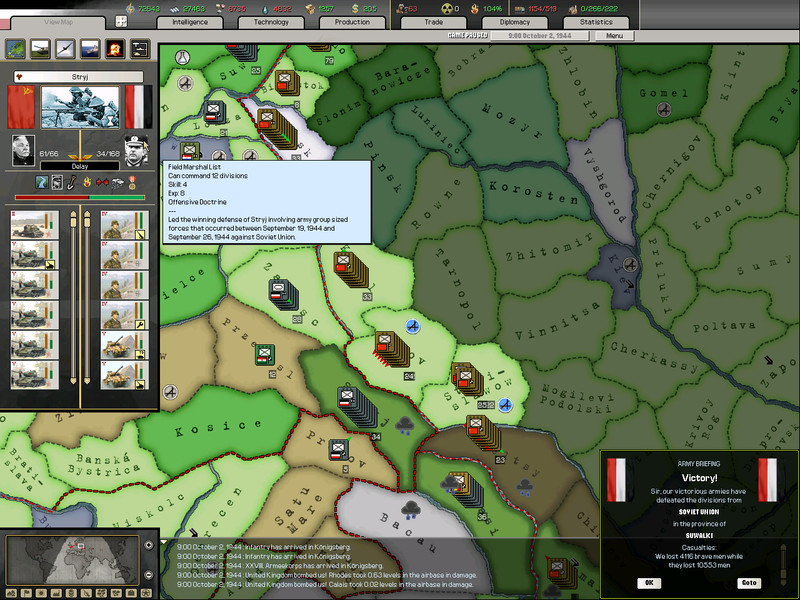
Field Marshals List and Model continue to perplex STAVKA, which keeps ordering attacks against the Wehrmacht positions.
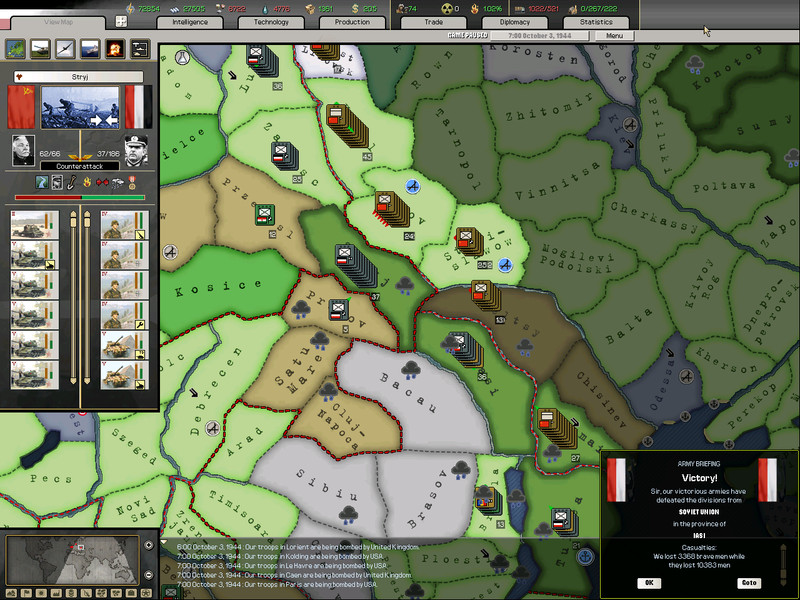
Barely pausing for breath, the Red Army renews their assault on Suwalki, even as the fighting in Stryj tapers off. Though the Soviets are losing troops, the Wehrmacht is being bled white of reinforcements and supplies.

French volunteers come ashore in the province of Perpignan. Troops are dispatched to make their incursion a short and bloody adventure.
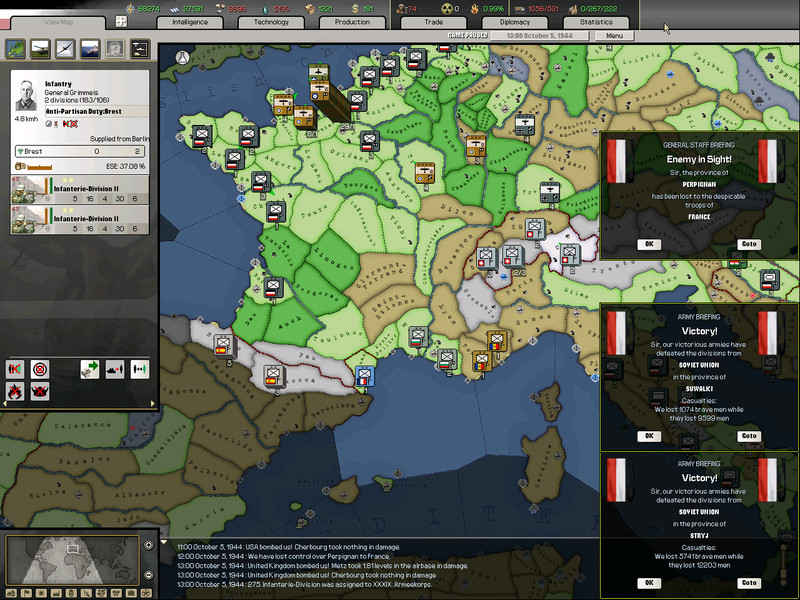
The Luftwaffe makes a timely interception, with good results. The Allied air forces are concentrating on the Atlantic coast for the most part. The depleted German interceptors struggle to keep them away from the heart of the Fatherland.

Palermo is taken by “stealth” and the supplies garnered are welcome additions to the shrinking stockpiles of the Reich. It is unknown if any Allied air units are affected by the base capture, but the drive carries on into Catania regardless.
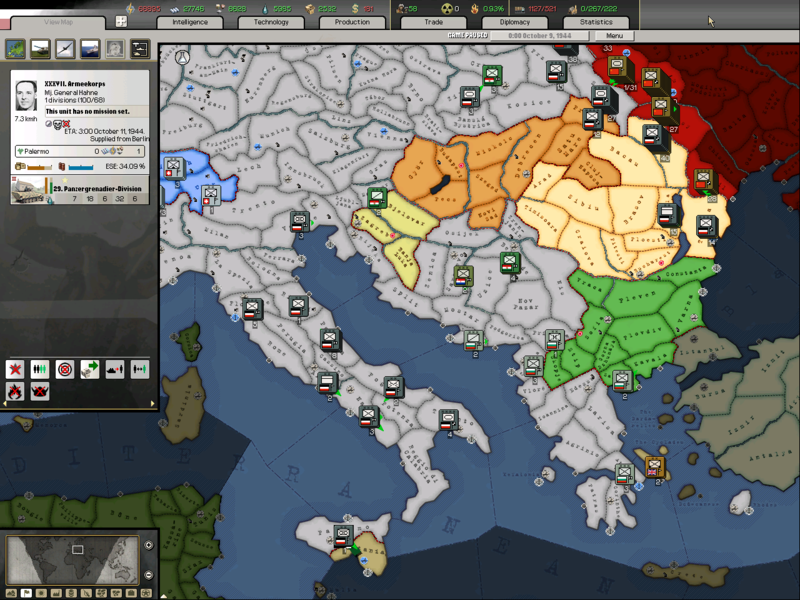
German fliers strike another blow…
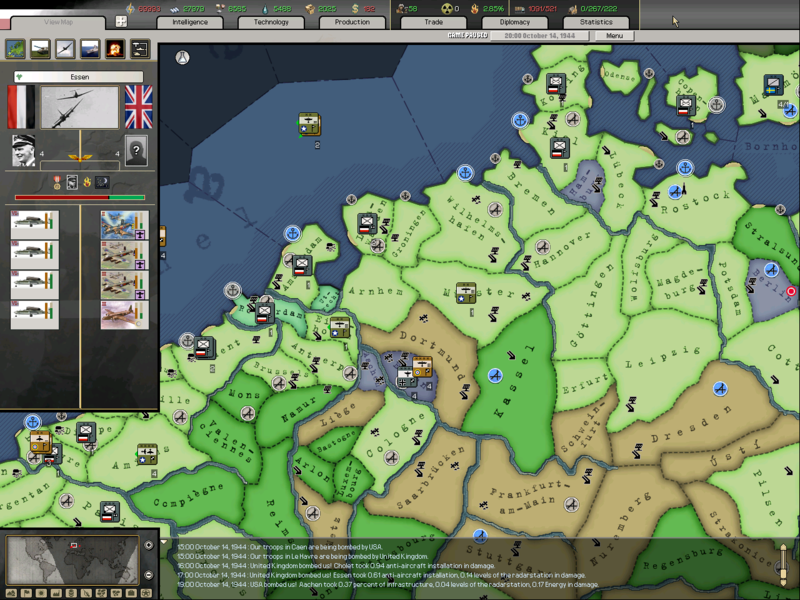
The Russians assail Suwalki once more, attacking into the teeth of Rommel’s defenses. The Soviet armored forces have suffered greatly in the forests here and are showing their damage and wear.

Lublin is attacked as well, as the cursed snow refuses to fall on the German side of the front lines!
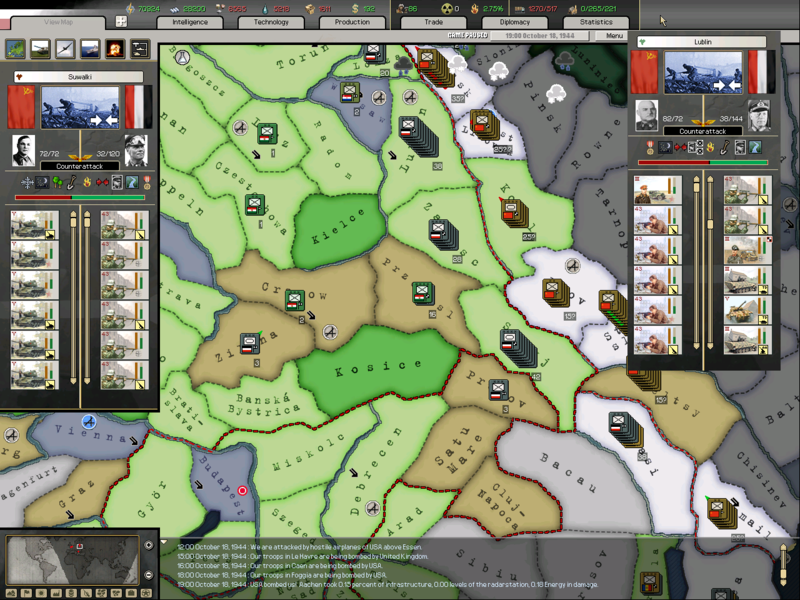
Lublin and Suwalki are held, with the Heer inflicting about 3:1 losses on the Red Army. Even at that rate the Wehrmacht may not be able to keep the pace.
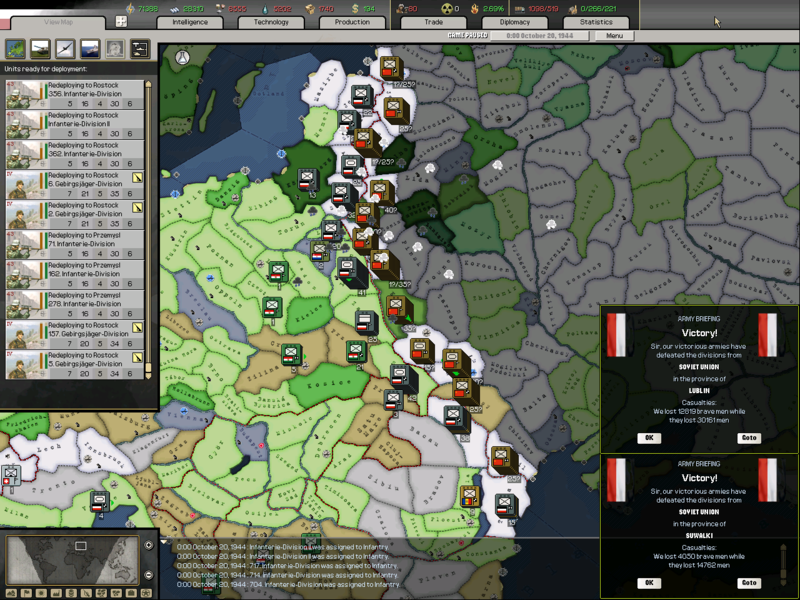
The skies over Stuttgart are contested.
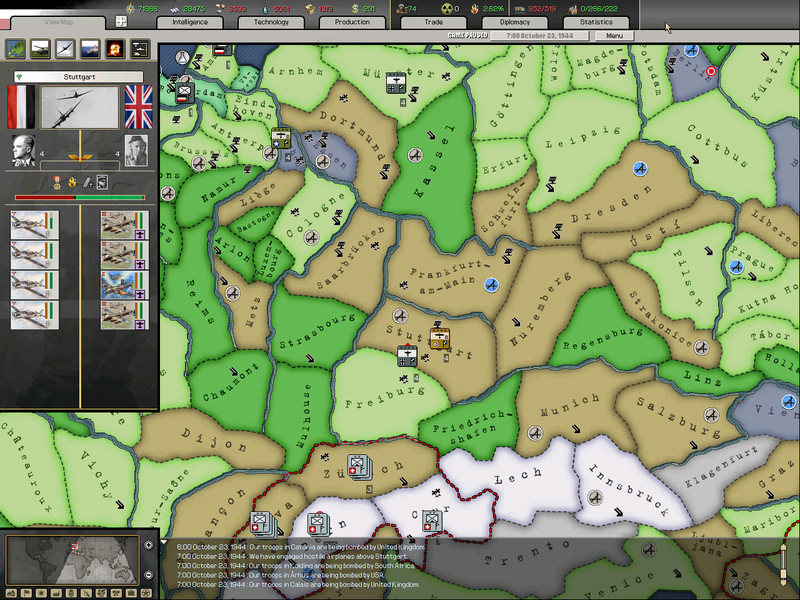
Field Marshal Model continues to hold fast against the Russian hordes in Iasi.

The Red Army pushes also in Stryj, but makes little headway against FM List’s dug in forces. The Soviets halt their drive in Suwalki after taking heavy casualties.

Field Marshals List and Model continue to perplex STAVKA, which keeps ordering attacks against the Wehrmacht positions.

Barely pausing for breath, the Red Army renews their assault on Suwalki, even as the fighting in Stryj tapers off. Though the Soviets are losing troops, the Wehrmacht is being bled white of reinforcements and supplies.

French volunteers come ashore in the province of Perpignan. Troops are dispatched to make their incursion a short and bloody adventure.

The Luftwaffe makes a timely interception, with good results. The Allied air forces are concentrating on the Atlantic coast for the most part. The depleted German interceptors struggle to keep them away from the heart of the Fatherland.

Palermo is taken by “stealth” and the supplies garnered are welcome additions to the shrinking stockpiles of the Reich. It is unknown if any Allied air units are affected by the base capture, but the drive carries on into Catania regardless.

German fliers strike another blow…

The Russians assail Suwalki once more, attacking into the teeth of Rommel’s defenses. The Soviet armored forces have suffered greatly in the forests here and are showing their damage and wear.

Lublin is attacked as well, as the cursed snow refuses to fall on the German side of the front lines!

Lublin and Suwalki are held, with the Heer inflicting about 3:1 losses on the Red Army. Even at that rate the Wehrmacht may not be able to keep the pace.

The skies over Stuttgart are contested.

LimaTango, there appears to be a small contingent of allied troops on the Greek Islands that you may be able to eliminate, if only a few divisions could be spared.

